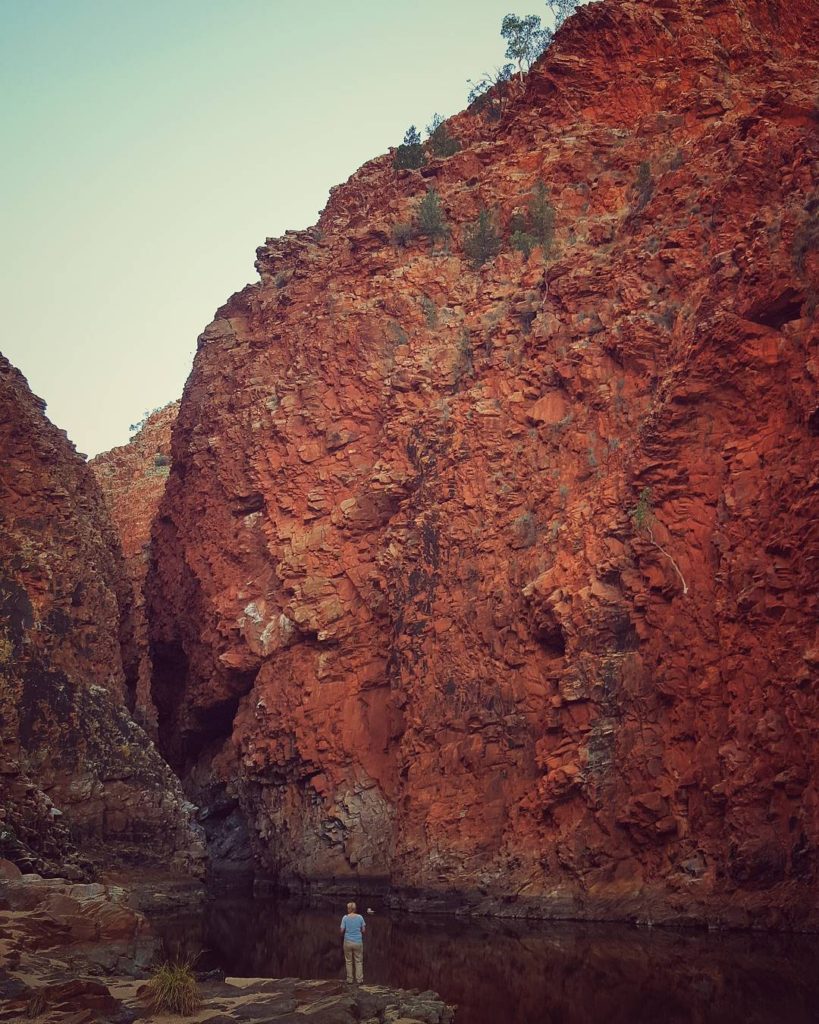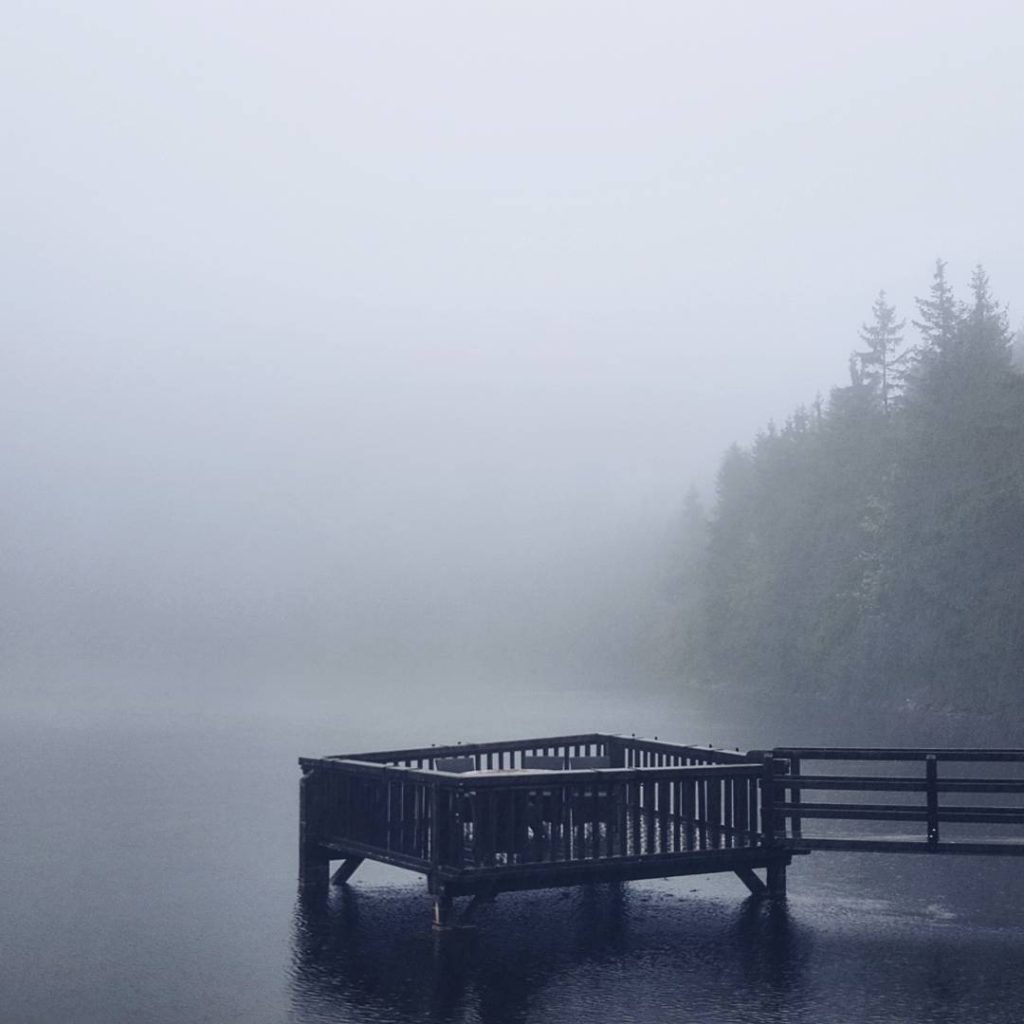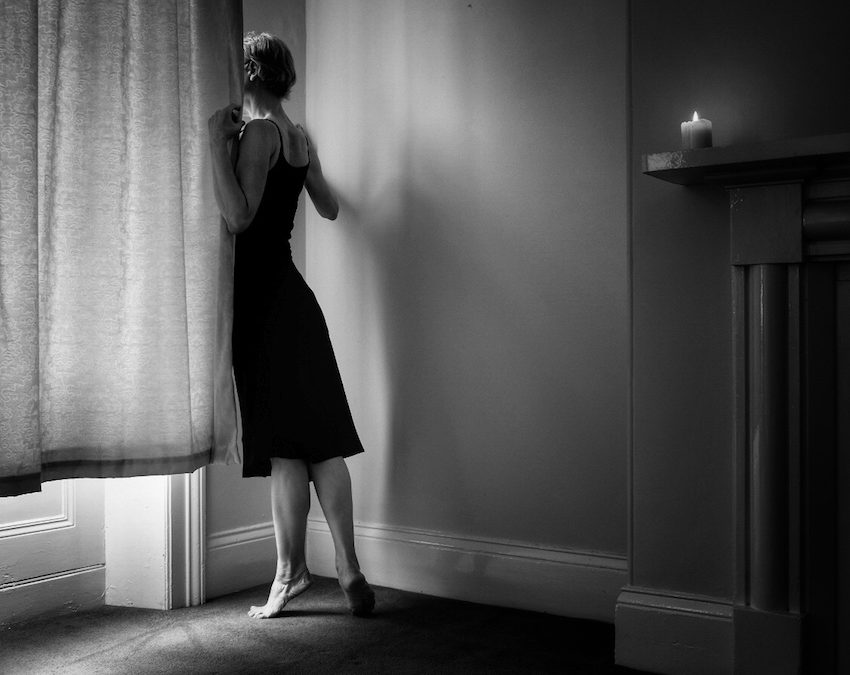
by Titika Røtkjær | Aug 18, 2017 | Black and White, Stories, Titika Røtkjær, You Are Grryo

One two three four
Cross
Six seven eight.

Balance, lean, follow,
Be aware,
Corazón y alma,
Relax, and keep the tension.

Open the door,
Walk, walk, walk,
It’s all coming back;
Two three four;
In a new way;
A new way;
Listen to the rhythm,
Sense the beauty,
Feel the strength,
Heart and soul,
Cross six seven.

Stop!
My world has changed:
It is a total secret,
That no one should know of.
It is awful private,
But far to heavy
To carry alone.

So I might just dream it,
And leave you the pictures
Frame by frame?
But then again:
I don’t want to re-
experience it all.

Two three four.
I still have to balance;
I still want to dance;
I still feel the tango.
Cross
Six seven eight.
I’ll bring the dark times to light;
I won’t fear them,
Although they know me,
And how to catch me,
And how to blind me.
I dare to touch them;
I dare to stay,
And reach for light.

I take off my shoes,
Walk past the curtains
(Like in a vision),
Open the window,
And breathe deeply.

I can feel a beginning,
It’s coming closer;
Almost like peace,
A vow transformed:
vision to matter.

Flexible body, flexible mind,
It derives from the soul,
Practice and effort,
Two three four.

I open my heart;
I drink the light;
I know it’s time
To leave soon.
Five six seven eight.

I move to the silence;
I count the beats;
It’s all in my soul;
It knows the direction;
It owns the music.
I sense the beginning,
It’s lifting me up
On wings of intention.
Cross
Six seven eight.

I watch the dawn behind the trees;
It’s glowing like trust.
The sky is burning
With light and answers
It’s time to leave.
The night is over
And time readjusted.

Two three four
Cross.
From an uncertain point
Between worlds
I touched the shadows,
Felt them in my eyes,
Felt them in my body,
Their density and cold
As I reached for the light.

Through a shimmering corner
Of my awareness
The light flows
Through chaos and joy,
Bones and soul,
Mind and muscles,
Heart and will,
And much more.
Six seven eight.
It flows through
From All that is.
Background:
I am a visual artist working with photography, based in Copenhagen DK and Norwich UK.
I was a dedicated dancer of Argentine tango for 13 years, when I was diagnosed with cancer.
In September 2016, I went through some tests at the hospital, just to make sure nothing was wrong. But, something was wrong.
Late one Monday afternoon, a surgeon called me. She explained that I was diagnosed with cancer located in my lower abdomen and that I was scheduled for surgery Wednesday morning 7.30. She gave me one day to get used to the thought. The operation would be performed by two surgeons, and it would take six hours. It was going to be a large operation. She advised me not to postpone the operation.
I was shocked.
I thought I would die.
Or at least be transformed.
I spent Tuesday trying to get used to the thought of leaving this planet.
The good thing was, when I thought of the people I loved – and still love – I had already told them they were in my heart. That was the most important thing for me.
Maybe it was the surprise of surviving the surgery that gave me tremendous energy and will power? Maybe it was just a miracle? Anyway, I tried to get out of bed the day after the surgery. I succeeded and felt that the healing process was in progress, and insisted on going home.
I soon discovered that my life had changed, and my perspectives too.
Not all of the changes were pleasant: four months after the surgery, I started to dance tango again. It was wonderful and easy and a total joy, with all the renewed energy. BUT, after one hour of dancing, my legs and lower abdomen looked like something that legally belonged to an elephant. They were swollen because of damages on my lymph system. It was terrible. I couldn’t stand the look of myself.
Even though tango is about heart and soul, it’s also an art form that is very much expressed through beauty, grace and elegance. I felt that these important aspects were out of reach.
I don’t want to bore you with long explanations about all the kind of therapeutic stuff I did every day (and still do) to dance again, and to prevent the lymphedema from becoming chronic (and the cancer from coming back); just tell you that I made this series for two reasons:
- To express important matters through art. By transforming something private into something generally human, it hopefully becomes meaningful to other people – and it might even make them feel uplifted?
- To convince myself that I don’t look like an elephant. Anymore.
To see more pictures by Titika Røtkjær, go to Instagram.

by Valeria Cammareri | Jul 31, 2017 | Stories, Storyteller, StreetPhotography, Valeria C, You Are Grryo
This story begins with two photographers: the first one, Christian, a Frenchman living in Arcachon, a little town on the Ocean, 70 km away from Bordeaux. The second one, Valeria, an Italian living in Milan.
They have met by chance in the virtual land of an app called Instagram in 2013, and for the last four years they have been sharing their thoughts about photography through two other apps called Viber and Kik. They have never met in the real world until now, though they have been planning to do that sooner or later. As they share not only a love for photography but also the fact they don’t like talking about their personal work, they have decided to write about one another. This is the first of two articles reassuming a relationship based on reciprocal admiration and a long conversation about the need for photography.
(Within dance the expression pas de deux refers to the number of dancers, men and/or women, performing together a sequence of a ballet or choreography.)
**********

I was a very “young” Instagramer with no awareness of my own work when I first came across Christian Mondot’s photography in 2013. I was making my first steps in the jungle of Instagram when I found his striking bw account (@cclm31) and I was caught off guard by all those images speaking so honestly of their author’s emotional side. It was more or less like when a child perceives the difference between himself and an adult, feeling the shape of authority. Compared to mine, his gallery had no contradictions or random images, but showed a definite strong identity. The most impressive trait to me was that all the images seemed related to one another, like words of a speech, and they were meaningful and soulful despite the absence of a garish subject.

I was in awe of his skillfulness in focusing on humble details, like an old washtub, a newspaper in an abandoned classroom, a closed door.


His extraordinary way of shooting the ordinary showed a contemplative eye to the world and spoke a language full of intimacy to my heart.
I realized in my naive approach to his photography how intensity doesn’t need spectacularity or drama, but rather a moved eye, and how the importance of a subject comes from the story the photographer sees or imagines behind it. Everything can become important when beautifully focused and framed, but it’s not just a matter of technical skill. The impact was strong but it took me a long period of time and more personal consciousness about photography to unfold the mystery and to understand the message hidden behind that work.

Preferred subjects to talk of his inner world are people and nature. Many of Christian Mondot’s photographs don’t feature visible people but rather their absence: melancholic shots like those of abandoned places full of traces left by their passage, empty restaurants frozen in the wait of customers, interiors of churches in the half light without believers.


Sometimes we get the human presence from a sign, like the light coming from a window, or a dog waiting for its master. Through this feel of missing people, Chris seems to talk of a lost Golden Era, full of warm relationships and expectations, like youth is.


These images without people and missing people are gloomy, and fascinate the observer with their ominous power: the unpleasant loss of the Golden Era is unavoidable. In more recent images, the presence of people seems rather to emphasize the serene acceptance of the loneliness of the human condition. Chris shows himself like a lone wolf, bashful and contemplative, loving his rich and multifaceted microcosm.


Nature is his best friend. Chris said to me he often gets lost in the beauty of landscapes, standing alone and totally overcome by the feel of immensity, absorbing the space around him in an impossible desire of symbiosis and waiting until he understands how to take “that” shot. Nature looks like Mother: peaceful, embracing and supportive. This side of Chris’s work suggests a powerful identity with mystical traits.

He is a professional musician, and music never leaves him alone as it is always in his head like a soundtrack. That’s why looking at his photos featuring awesome countrysides or marvelous sea landscapes, I have often sensed a sound, like a whisper, growing until it becomes the din of an orchestra tuning its instruments.

Chris uses a poetic black and white language to tell an endless series of little stories. He has a very personal use of black and white: his black is deep and enveloping, often taking most of the image, sometimes soft like velvet, others very intense and dramatic. Inside it, smooth like a caress or sharp like a blade, the light insinuates itself, showing beauty. He uses his whites coming out of all those blacks like a curtain raised to reveal the truth. It’s a mystical light and I have often felt in awe of his way of engrossing the observer: ravished and sucked inside the frame, we are called to take part.

Christian Mondot’s photography fulfils its author’s wish to engross the observer in his own emotions. These are artistic photographs, evoking much more than they show, involving more than what they feature.
There’s no way to escape a personal participation in these charming stories, so be ready and enjoy them.

You can find Chris on: Instagram | Website

by Simran I. Nanwani | Jul 21, 2017 | Mobile Photography, Simran I. Nanwani, Stories, Storyteller, You Are Grryo
When taking photos, there are times we feel the images we captured aren’t good or maybe we lost our touch. Thus, we spend time looking for inspiration and motivation in photography by looking at people’s feeds on Instagram or other photography platforms. It isn’t because we failed; rather, our willingness to learn and keep growing gives us the thirst to be better. Seeing others’ feeds brings a new feeling and often a new perspective to moments.

Suddenly Sherbet by Jay McCullough
It is hard with the advancements and, of course, competition in photography these days. But we must not forget why we started taking photos in the first place. Yes, getting commercial has become important to some. Yet, for many of us who started photography as a passion, we shouldn’t lose our way. Through my journey in photography, I feel if we forget that first moment we started capturing and don’t continuously relive that feeling, then, however professional we get, at one point the taste and enjoyment of it will fade. Many photographers in the past kept clicking and stayed humble to their passion, which is why we always feel inspired through their work. Compromises may have been made, yet their brilliance remained true.
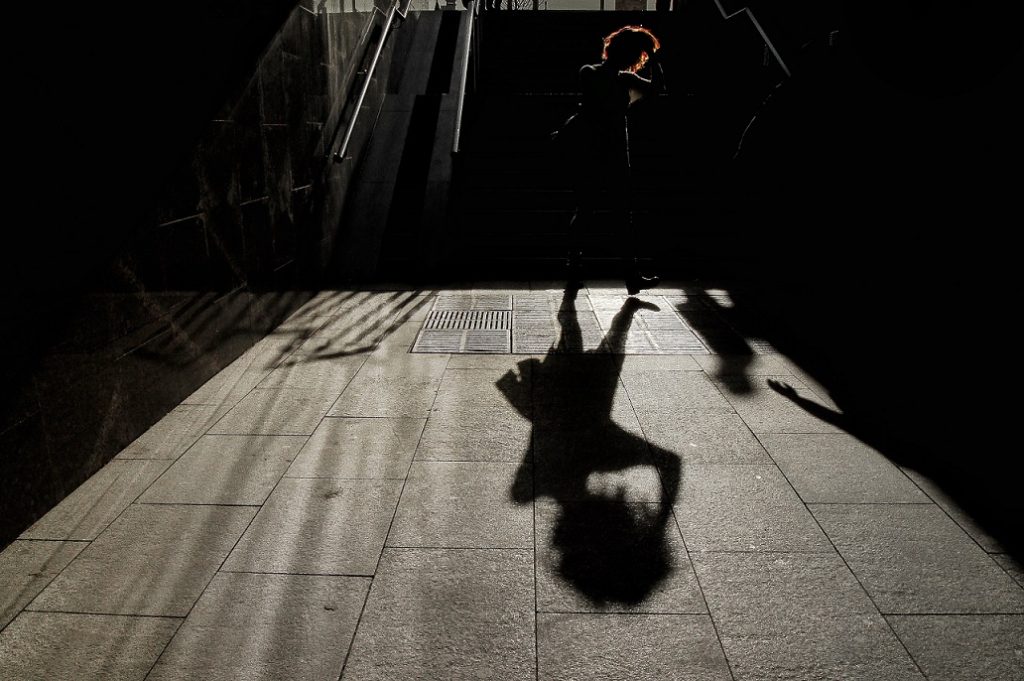
Light by Victoria
Coming across the feeds of Aki Sato (_akisato_), Victoria (vi.or) and Jay Mccullough (jmcullough) was one of those moments for me. Their feeds and photos bring a fresh feeling. The first time I saw their images, I was amazed at their captures, clarity and perspective. Each of them have different styles, unique in their own way. The idea and motive to keep it original has lost its way for many, but when seeing their feeds, I was convinced that there are some who want to stay original and be themselves.
Here are a few words Aki and Jay share about how it all started for them :
I live in Tokyo, Japan, and I’m an instagrammer taking photos with the iPhone 6s.
Photography has always meant something to me. But I’ve got a different point of view of my city and my photos after a Copenhagen trip in 2015.
Before I went to Copenhagen and Stockholm, I had no impression about my city because I’d been so busy at work. Tokyo was just a place to work for me. As you know, Tokyo is one of the busiest cities in the world. I had no time even to look up to the sky. In Copenhagen and Stockholm, I met lots of happy people. They were proud of their city and enjoyed their life even though they worked so hard like us. I really loved them. After the trip, the scenery of Tokyo was totally different from before. Everything looked very fresh, even if it was a flower on the street. The trip opened my eyes and it was so inspiring.
Also, I really love a simple interior and monotone fashion, even in my everyday life. ~ Aki Sato
I’ve loved photography since I held my first camera in grade school. This interest carried through high school and college, influenced by everything from Ansel Adams to Rolling Stone magazine. I’ve enjoyed photography throughout my adult life, but it became a regular and serious hobby for me a couple of years ago around the time I started using IG. Since then, my love and interest for photography has grown exponentially. From minimalism to mood to light to magical moments with my children… I could not be more in love with capturing beauty and artistic expression through photography. ~ Jay McCullough
Victoria’s words can be seen here.
Simple and minimalist are not easy to approach in photography. Some people have a sense for it and are able to capture the essence. Aki, Victoria and Jay have done a fine job in showing how simple things can stand out stunningly. Their photos speak of various moments. Every photo is telling you a new story. Aki’s photos form an intertwining story of their own and make you see Tokyo from a new angle. Victoria captures minimalism in street photography through her creative eye. Jay magically captures various moments in daily life filled with colours.
Let’s create the story through their photos below :
*With structure

Architecture by Aki Sato
She stood there on the stairs, whilst time stood still. She wondered and waited in silence for that one moment when her friend would say, “Hey, I am done, let’s go.” Once she saw the picture she was in awe of how beautifully her friend framed her in this simplistic setting.
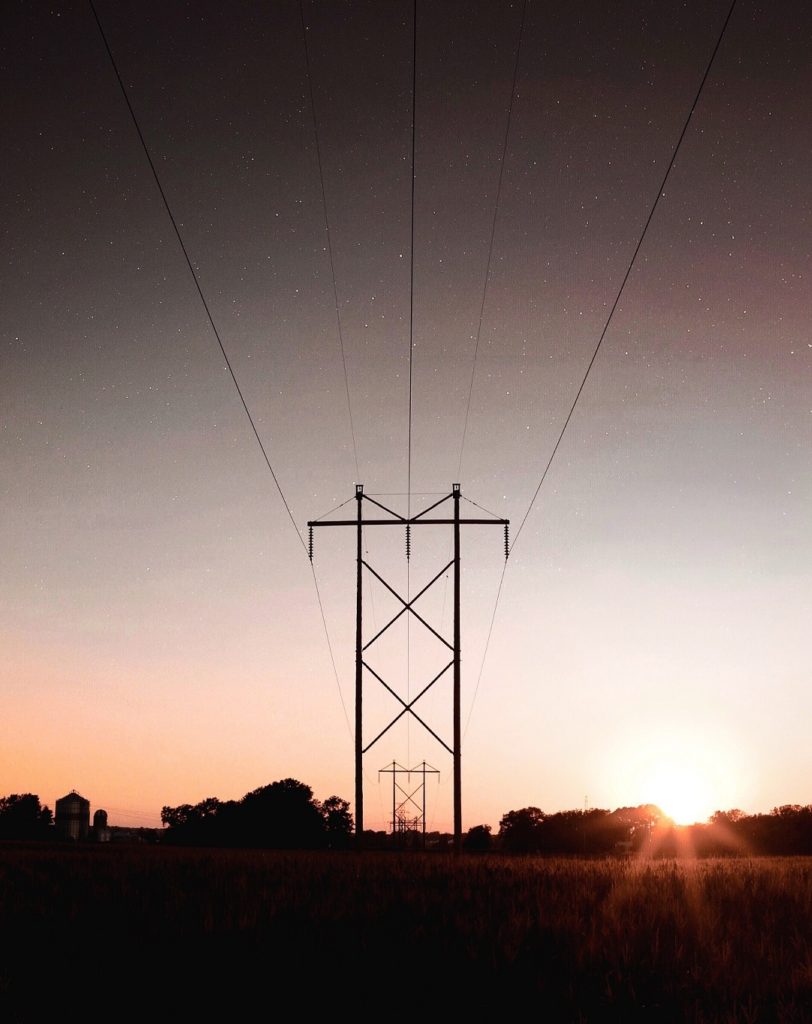
Midsummer Night Dream by Jay McCullough
He walked through the fields during sunset. The impressive lines from the power lines striking through the skies formed a lovely, simplistic structure. Intrigued by the colours of midsummer, a thought crossed his mind. “Should I enjoy this moment and let it pass or should I take my camera and hit the shutter?”
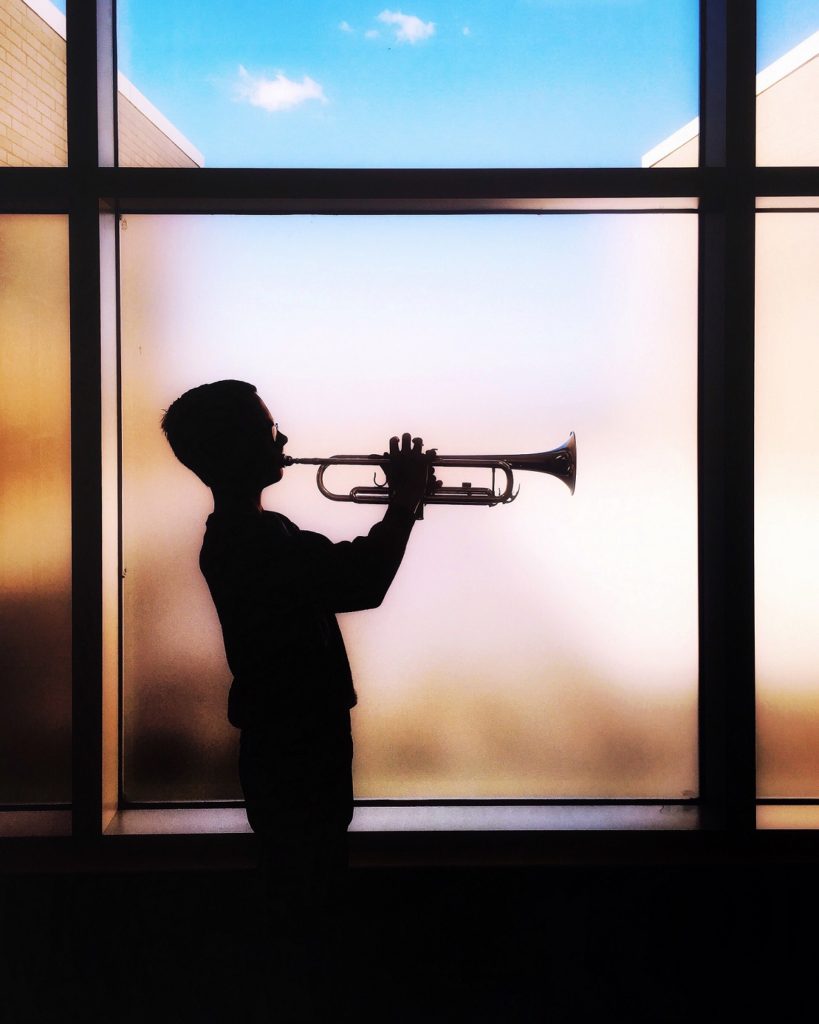
Paint the Silence by Jay McCullough
Melodiously, the voice of the trumpet resonates around the house, creating a classic and soothing rhythm. Everyone starts to enjoy the peaceful atmosphere whilst continuing their household chores. Jay, feeling inspired, pictures a colourful moment in his mind and instantly clicks.
*On the street
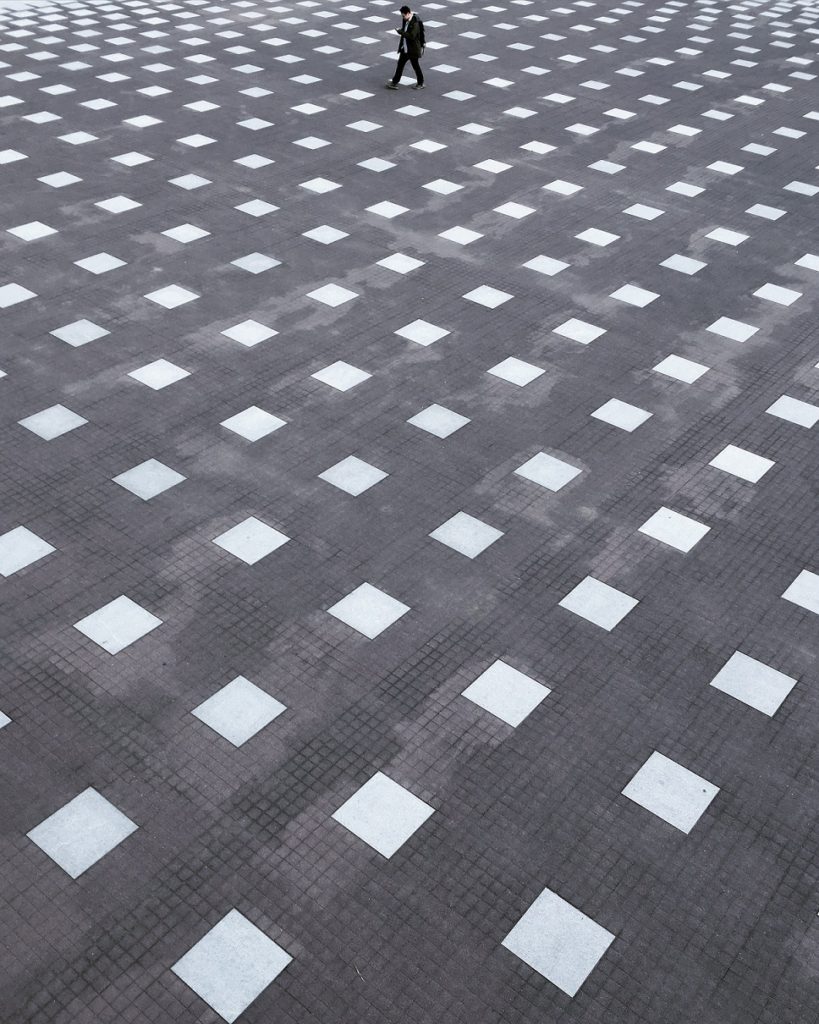
Street by Aki Sato
He walks whilst looking at his mobile after work. Checking his messages and missed calls on a quiet empty street. Oblivious and in his own world, from a distance, a photographer, triggered by the patterns on the floor, instantly captured this moment and, voila, he is frozen in it.

Green by Victoria
Her prominent red hair stood out against the teal background. As she passed by through the light and shadows, thinking of her next appointment, the photographer felt it was the perfect moment to capture. After playing with some angles, she finally clicked.
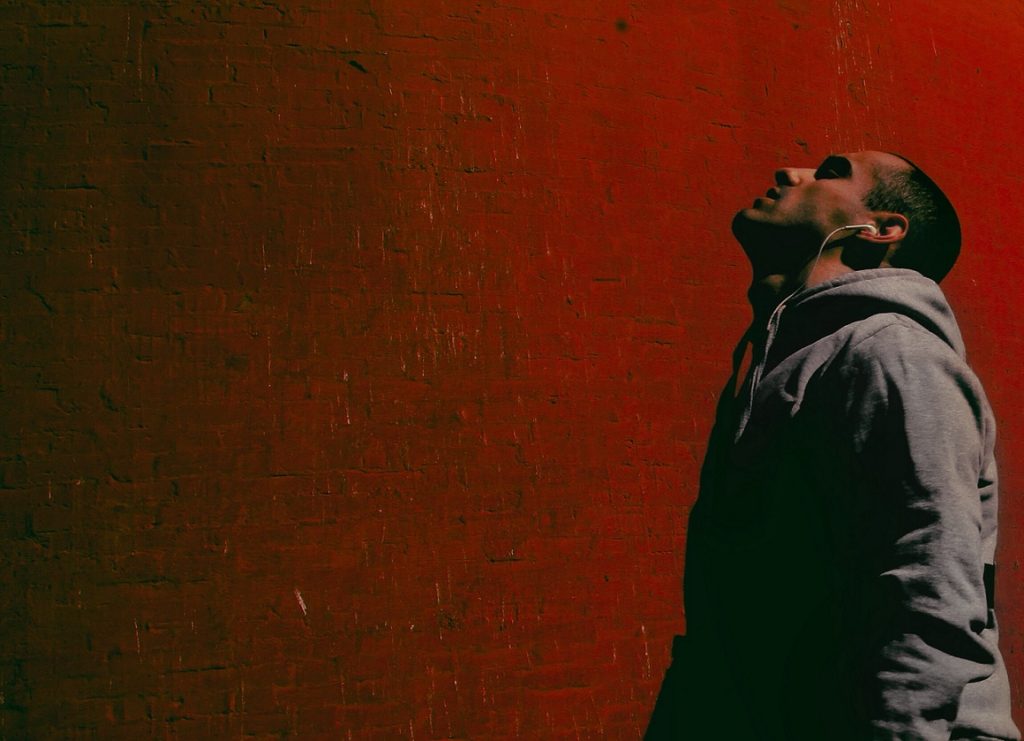
Red by Victoria
Lost in trance, the music flowed through him, bringing him to a new place and atmosphere. He felt carefree and refreshed embracing the moment. Victoria, forming the shot in her mind with the stark red background and the man rapt in his world, hit the shutter.
*At stairs
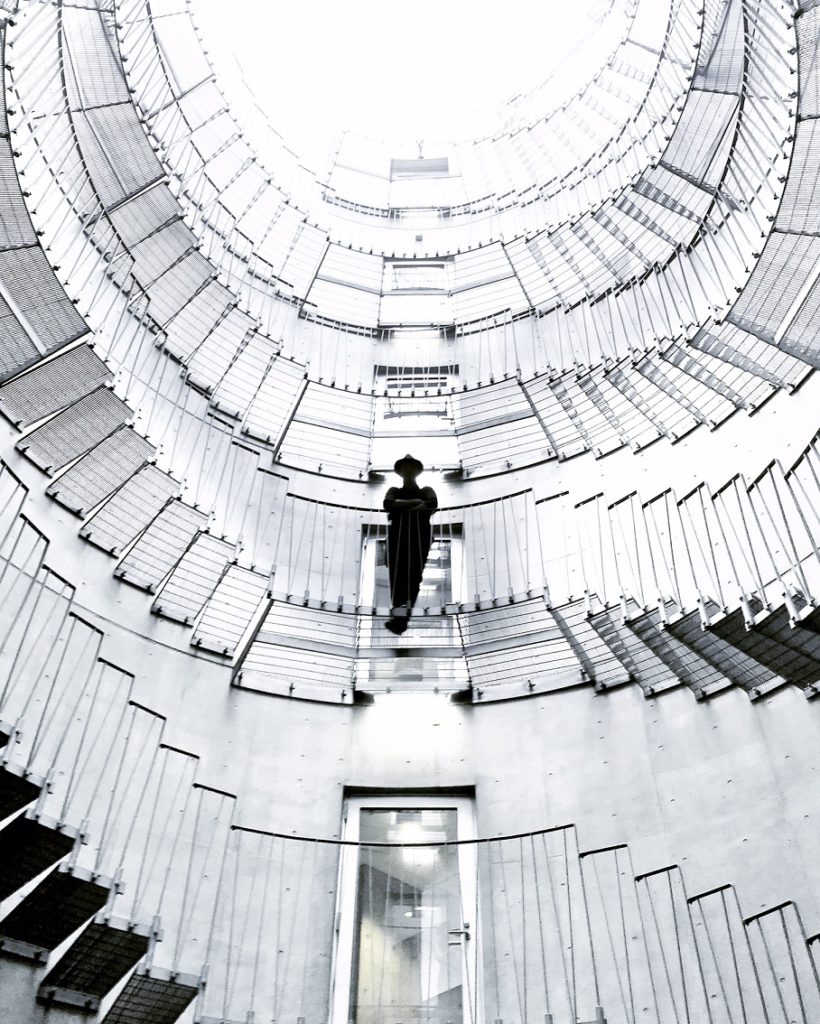
Stairs by Aki Sato
Standing at the center of the stage looking at the audience applauding his marvelous production, humbles him. He is proud of his first-ever successful moment. He thinks, “Wow, one day, it shall come true.” Looking up at the stairs spiraling through eternity inspires her to create a moment that stands still in times to come.

Stairs by Aki Sato
Running through the stairs of eternity, she looks through the crisp blue skies joyfully and blissfully. From behind, she hears a murmur, “Hmm, the steps look great. I wish she would climb faster so I can frame the shot and capture it.”
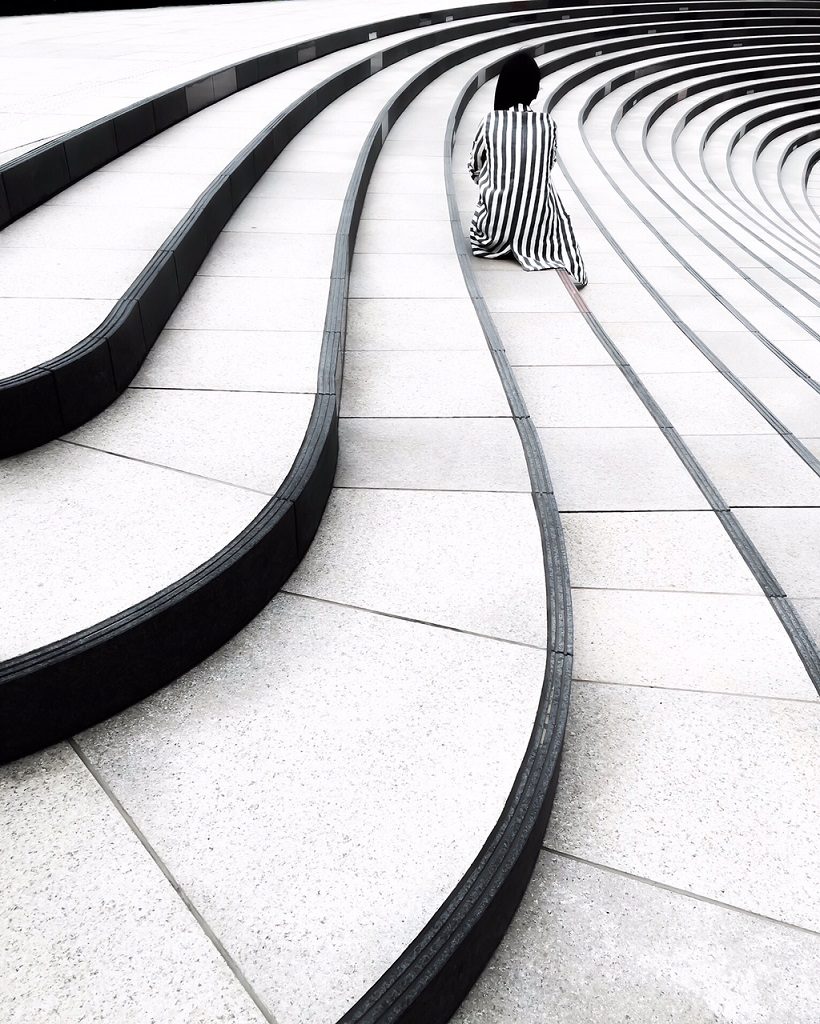
Stairs by Aki Sato
Wandering back into her past, and exploring her present, she sits contemplating how time has passed. Having no regrets and continuously moving forward in faith she smiles. Aki, her friend, through the flowing patterns and stairs clicks a vivid snapshot, then calls out, “Hey, look here, let’s go!”
*Chasing the shadows
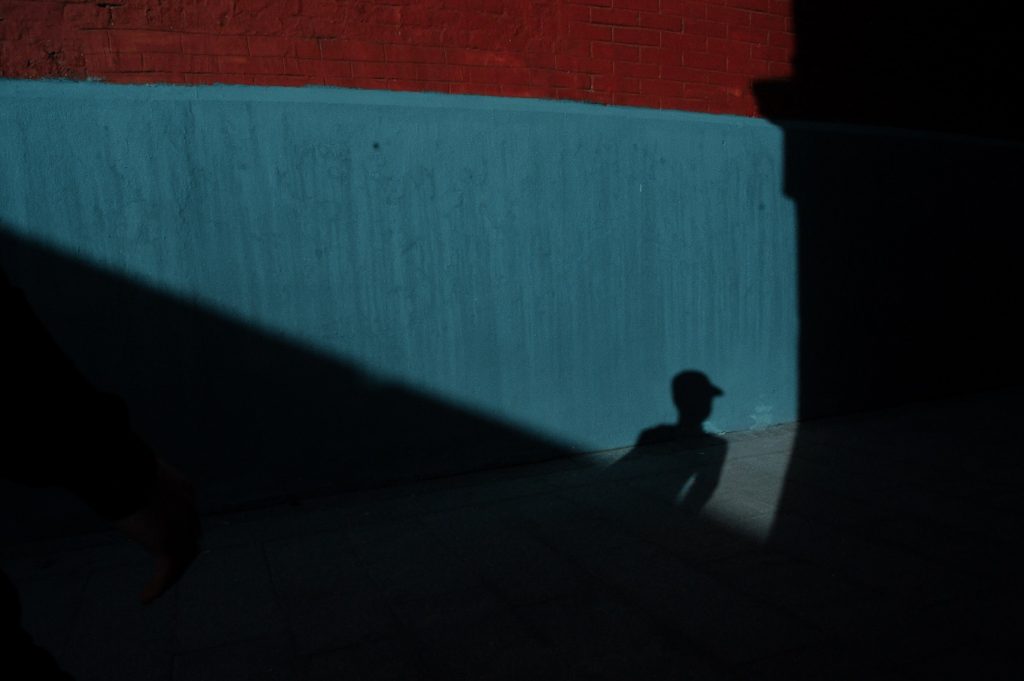
Blue by Victoria
In anticipation she stands peacefully whilst looking at the shadows and colourful background weave through the reflections of the sun. The subtlety of the moment injects her to create this lovely masterpiece.
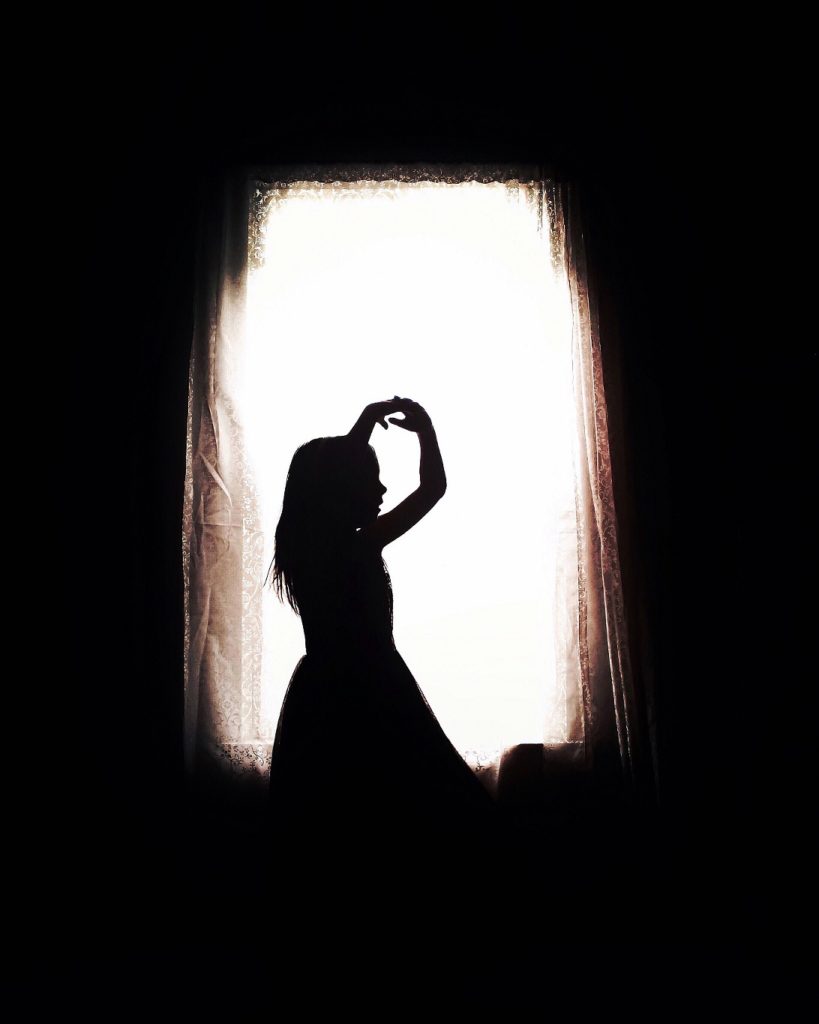
Dream Awake by Jay McCullough
Shyly, she practices ballet near the window thinking no one’s looking. Gracefully, she enjoys herself in the movements. Her father, quietly smiling, sees the opportunity of a beautiful moment to capture. Picturing the sunlight rays forming a shadow and lovely silhouette of his daughter, he snaps his shutter.
Through their photos and our personal photography journeys, we can see how we can influence one another. Changing vistas, new angles, patterns and structures bring with it a fresh outlook on photography. Let us continue to find our sparks in each other whilst growing to build our passion!
See more of their feeds on Instagram Aki | Victoria | Jay
Thank you, Aki, Victoria and Jay, for allowing me to express through your beautiful photos.

by Santriani Jaon | Jul 14, 2017 | Santriani Bohani Jaon, Stories, Storyteller
“Now, we are Fez!” Mohammed, our driver, announced in his broken English.
I sat up, bolt upright, shut my laptop and looked out the window. Something about the air in Fez gave off a sense of rawness that was so characteristic of Morocco herself. But if the streets of Marrakesh, where we’d just come from, were dipped in the deep terracotta hues of sunset, the labyrinthine streets of Fez’s centuries-old medina were kissed with the dusty sand-coloured tones of the Sahara.

Mohammed’s sharp voice cut through the air as he called the hotel to get directions, turning the steering wheel with his free hand. We weren’t even in the medina yet, but we were already lost. I didn’t mind, though. To me, one of the most eye-opening experiences of traveling anywhere is getting lost.
As we circled around attempting to make head or tail of our location, we’d ended up passing through a street that curved around the edge of a hill overlooking the rest of the city below several times, giving us a spectacular bird’s eye view of the entire city more than once.

Twenty minutes later, we stopped outside one of the entrances into the medina, luggage in tow, waiting for the riad staff to fetch us and sticking out like sore thumbs.
Bakeries, grocery stores, dimly lit teahouses and spice shops lined the road, and bearded old men sat in silence outside small restaurants, sipping mint tea and frowning as they scrutinized their surroundings. Young men pushing carts laden with everything from bread to clothes to old machinery shouted their way through the crowd, and pairs of women dressed in bright-coloured Moroccan djellabas shuffled in and out of the medina.

Children scurried about, weaving through the crowd and shrieking gleefully as they played together. Just inside the gateway, fruit sellers hawked their wares on wooden tables, and the aroma of freshly roasted corn wafted through the air. Just being inside the medina was a feast for the senses.
But some things stay the same no matter which part of the world you’re in: crowds of men of every age huddled together inside teahouses, rapturously watching soccer games on the TV, their conversation interjected with bouts of cheering and jeering.

The entrance to the riad we’d be staying at for the next two nights was an inconspicuous glass double door almost completely hidden behind two grocery stores, which left us feeling more than a little hesitant. But the humble entrance belied the exquisite interior of the riad. We were led down a tastefully lit hallway decorated with bright Moroccan zellije tiles of blue, red, yellow, white, and green, which opened up to a wide open-air courtyard whose emerald green tiles glinted in the sunlight cascading down from above. Plump white pouffes and ottomans neatly circled small hand-carved wooden coffee tables, and the faint scent of sandalwood drifted through the entire riad.


This, I learnt, was a hallmark of Moroccan and Islamic architecture. Traditional Moroccan riads were often purposely designed to have unimpressive exteriors that suddenly open up to elegant inner courtyards enshrouded in privacy, symbolizing the primacy of inner beauty over outer appearances.
In fact, Fez’s entire medina was infused with this elusive sense of hidden beauty. Every narrow alleyway and shophouse-lined avenue within the medina seemed to radiate so organically with a rugged sense of practicality that still somehow managed to be delicate in its beauty. Wandering through the maze of streets in the medina, I found so much attention to detail in the otherwise mundane.


Public water fountains dotted the streets, each of them breathtakingly decorated and painted in vivid colours that came together in an explosion of luminosity. Huge wooden double doors that stood at the entrance to almost every riad, restaurant, Sufi zawiya (spiritual centre), or mosque were embossed with calligraphy and arabesque carvings. Some of the streets in the medina were covered with wooden lattice structures that served to provide shade from the desert sun and filter just enough sunlight to brighten up the narrow walkways without making it too warm. And despite the abundance of butcheries and fish stalls all over the medina, no matter how many times we walked past, there was never any stench or any kind of unpleasant smell that is so often associated with wet markets, because the produce in Fez is always fresh.

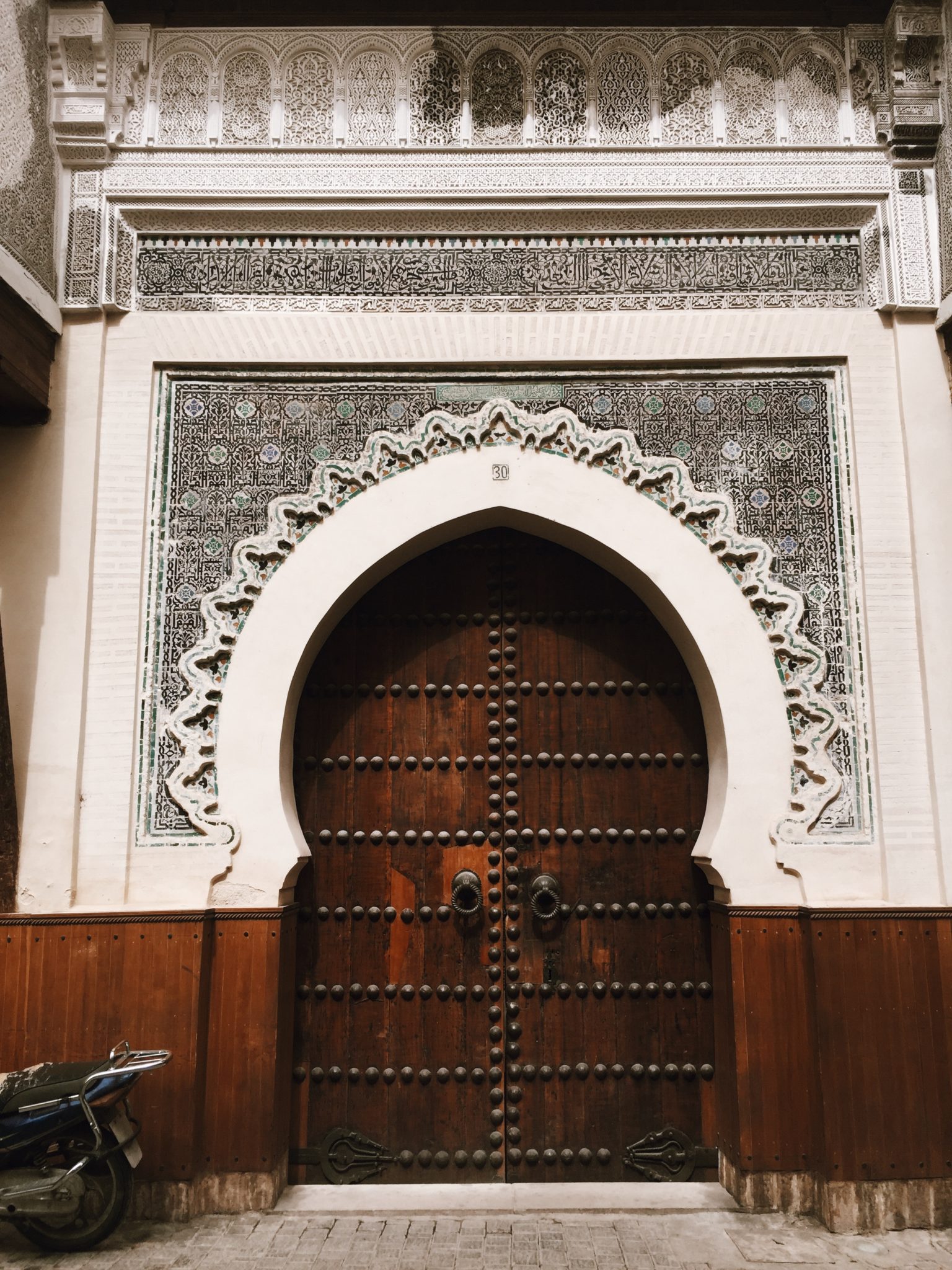


The myriad alleyways winding through the medina appeared to be deceptively stuffy, yet the minute I stepped out of the blazing warmth of the streets outside the medina and into any of the alleyways leading into the medina, I was enveloped in a cool embrace that seeped into my skin and instantly refreshed me.
It turns out that the materials used to build the houses within the medina were specifically chosen because of the cooling effect it had both inside and outside the house.

Even though a unifying colour scheme of creams, browns, and greys runs through most of the medina, occasionally, the desert-like hues of the medina were interrupted by vibrant splashes of colour that popped out of nowhere.
As I made my way from site to site within the ancient medina, I came across a rainbow alley packed with displays of oil paintings, bracelets, carpets, bags, and prayer mats. A group of street artists had taken it upon themselves to literally brighten up a dark alleyway within the medina.

As I continued wandering around, I caught a whiff of an overpowering fragrance which beckoned me further and further into the medina until I found its origin: a small shop selling pink rose water that was being made and bottled on the spot. A bespectacled young man in a lime green t-shirt, camo pants and a red taqiyah (Muslim skullcap) stood amidst huge woven baskets of pink rose petals and neatly packaged glass bottles of rose water, diligently simmering the rose petals in water.

Because of the brown monochromatic colours with which she’s predominantly painted, Fez herself may initially come across as rough around the edges and even drab compared to other Moroccan cities.
Yet the maze-like streets of its pristine, ancient medina immediately sweep residents and travelers alike into a cradle of veiled beauty whose authenticity is at once rejuvenating and calming in a world that, in so many ways, has lost its heritage to the throes of modernity. I know I’ll be back here again, one day.
Santriani is a freelance writer based in Singapore.
You can see more of her work at the links below:
Blog: Blancslates
Instagram: @blancslates
Facebook: facebook.com/blancslates

by Antonia Baedt | Jul 11, 2017 | Antonia Baedt, Mobile Photography, Stories, You Are Grryo
How my mobile phone helped me to discover photography and what I learned along the way
Not too long ago the number was 36. That was how many pictures you could take with one roll of film. I went through about three of them per year. Two for the holidays and another one for the remaining family get-togethers. The constant lack of remaining shots on the film, the hassle of taking that little black box to be developed – it’s safe to say, I wasn’t a fan. To me photography felt complicated and out of reach.
Digital photography came along and things changed. People around me still took photos of their holidays and families. But now it wasn’t 36; now it was more like 360. I would sit through endless photo presentations, but picking up a camera myself wasn’t an option. Things seemed to get even worse when mobile phones turned into cameras. I remember buying my first smart phone. “I want to make phone calls and send text messages, why does this thing have a camera?” Oh, sweet ignorance…
They get us all in the end
Eventually, while everyone else was already busy taking selfies and stuffing Facebook with pictures of their daily lives, my inner photo geek awoke. First, it would only stick out its nose into this wondrous world of social media and mobile photography, quickly retreating whenever someone accused it of finally being interested.
What really caught my attention were blogs and, of course, Instagram. There I found people using their phones beyond the odd snapshot. For years I’d visited Instagram pages in my browser. Just for their photos. The social part of the app was too far out there for that little photo geek. Consumption okay, but sharing? No way! It takes confidence to put yourself out there. Most Instagramers, like me, are not professional photographers. However, this isn’t National Geographic, it’s a phone app and we all learn a thing or two as we go along.
The best camera is the one you have with you
Yes, I know. Phrase-mongering! But it’s still true and I learned the hard way. It was my second visit to Australia. The first time I went, the camera I brought gave up on me after two weeks. So one year later I returned home with only two photos, and a travel diary, but that’s another story.
Armed with a new DSLR and lots of determination, this time I was going to get it right. However, DSLRs are heavy and did I mention complicated? So it stayed in my bag for most of the trip. Not so my phone. It saved the day more than once and slowly but surely taught me to approach photography from a different point of view. That of a storyteller.
Getting to this place meant a long hike through a dry river bed and the burning heat of the Australian outback. We started before sunrise. Guided by the light patches of white sand, we made our way through the bush and gum trees rattling in the morning breeze. Without sunlight the rocks appear black. They radiate the heat from the day before and there is a distinctive scent in the air that can put me back to Australia in an instant.
As we reached the bottom of the river bed, the sun began creeping over the edge of the gorge and turned black into glowing red. It was beautiful but also meant we were up against the clock. Walking back with the sun up was not an option. So when we finally got to the end of the gorge there was just time for a few pictures with my mobile phone. The big camera stayed in my bag the entire hike.
This guy was about as big as the tip of my thumb. There were thousands at this beach in Tasmania. We had a blast trying to capture them in a photo without having them retreat into the sand or running away. This was a beautiful place and sunset, but I would not remember it as vividly had we all not spent an hour or two chasing crabs with our phones.
There is a difference between capturing the essence of a memory and a snapshot of a moment
At some point during my trip I began capturing things simply for their uniqueness or beauty. These photos have no story, but they form one if I put them all together.
They aren’t about what happened but what it felt like to be there. The color of the water, the texture of the sand and maybe even the sound of the birds in the morning and the scent of the gum trees at dusk. The details of everyday life.
Suddenly everyday things become special
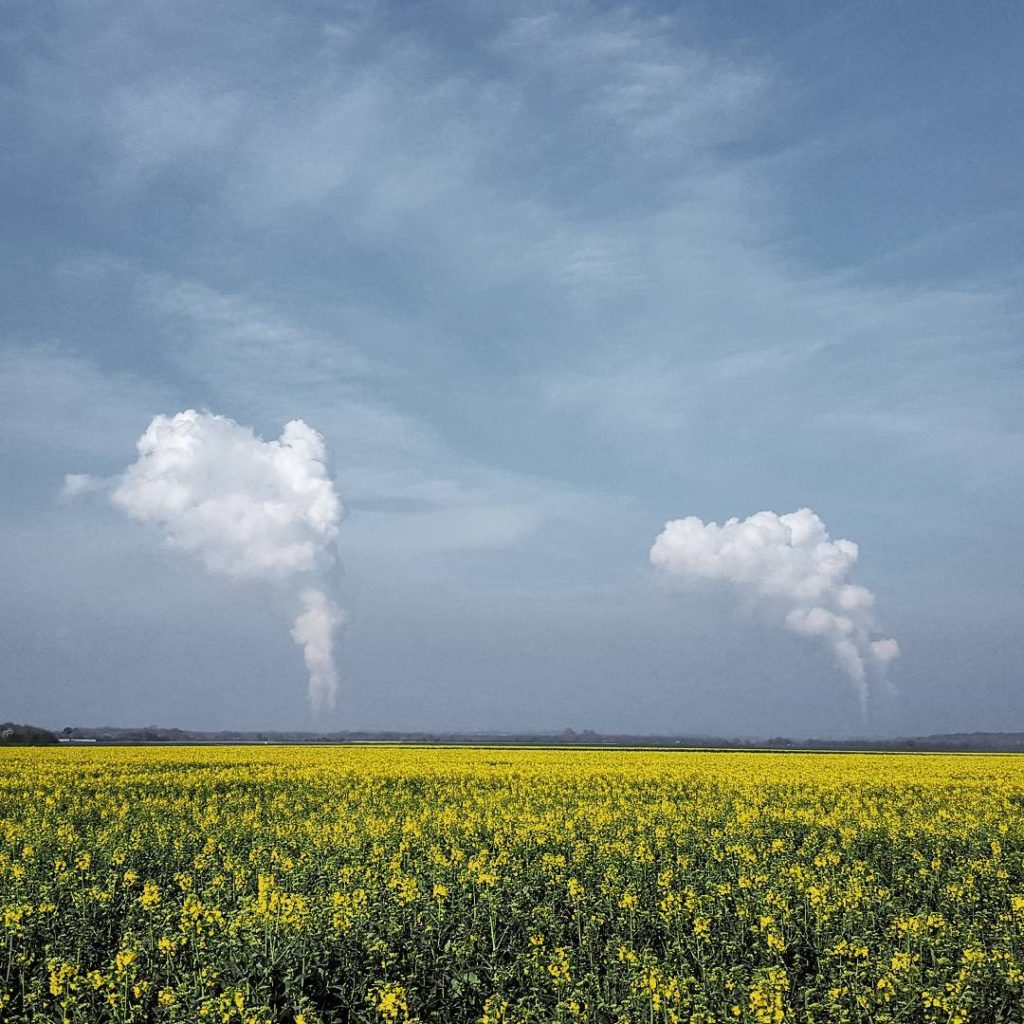
Power plant along a freeway.
We all know them. The things we pass by on our way to work. They are familiar and yet we rarely pay attention to them. Especially when they represent the negative things of what we do to our environment. This, however, caught my eye. Since my phone camera and I have become better acquainted, I catch myself looking for interesting shapes and colors. I had stopped at the side of the road for the canola field, but ended up posting this on Instagram.
Sometimes a picture can make my day. Like the cool T-shirt you got for a bargain or the train you almost missed.
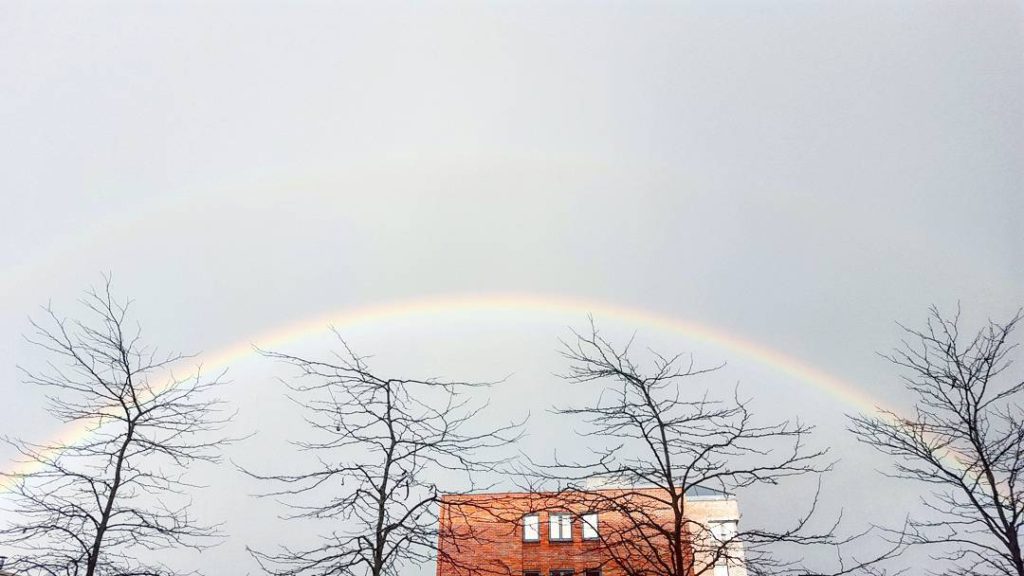
The perfect ending to a not so perfect day at the office.
For the non-professionals among us, our phone can be our best friend
I admit, I like my DSLR and I use it often. There are things that my phone just can’t do and I enjoy the challenge of learning about exposure, aperture and all those other things. But there are times when it’s not my camera but my ability to use it that reaches its limits. And more than once my phone has gotten me the photo I wanted.
This is not fog. It’s the heaviest rain I have ever been in. A sight to behold, but my camera wasn’t happy. Holding the camera in one hand and the umbrella in the other I just couldn’t get anything in focus. Freezing, drenched and quite annoyed I finally took a few shots with my phone. Not perfect, but sooo much better.
My phone makes me a hunter for opportunities
I am a writer and sometimes I desperately look for a picture to illustrate a thought. That’s when I go on secret photo missions. Wherever I go, I try to create an image that will translate that picture in my mind into something others might recognize.
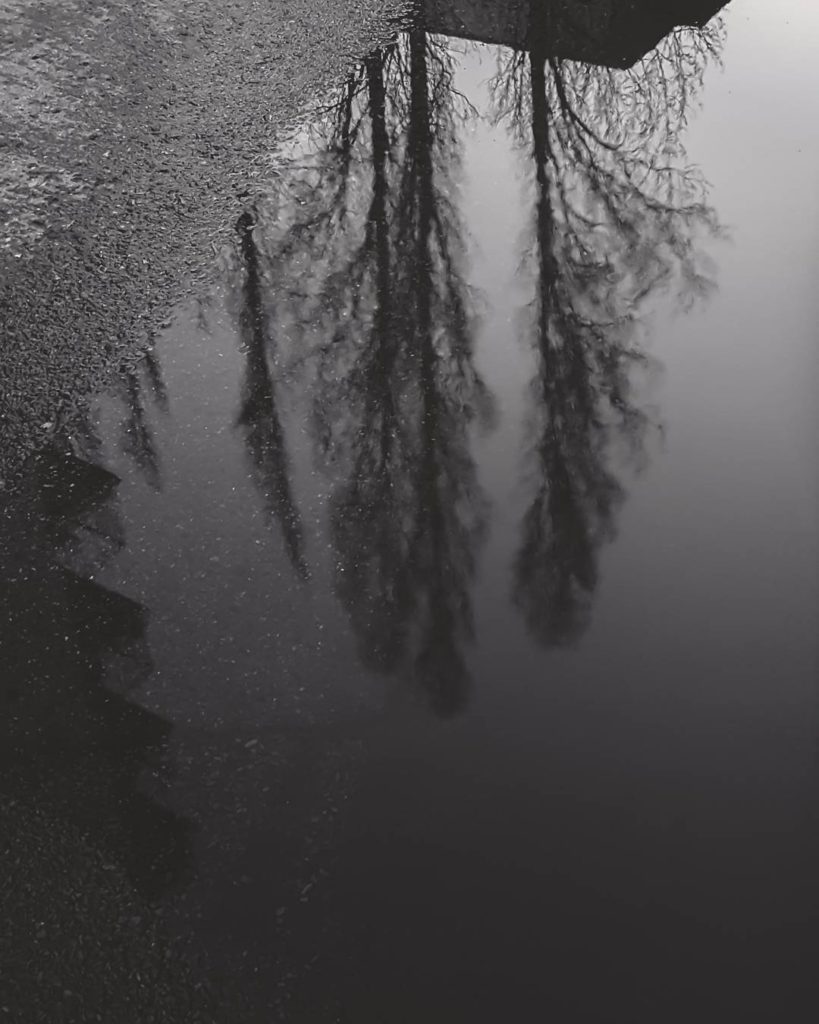
Instagram caption: What if you could jump and dive into that other world?
And sometimes it is a song.
“There is nothing more difficult than talking about music.” – Camille Saint-Saëns
? Camille Saint-Saëns – The Aquarium, Carnival of the Animals ?
Gadgets – every photo geek’s dream
Be warned! There comes a day when even the humblest mobile photographer opens their bag and it’s full of equipment. Halfway along my journey, I discovered gadgets. My favorite is this tiny lens that produces the most amazing macros.
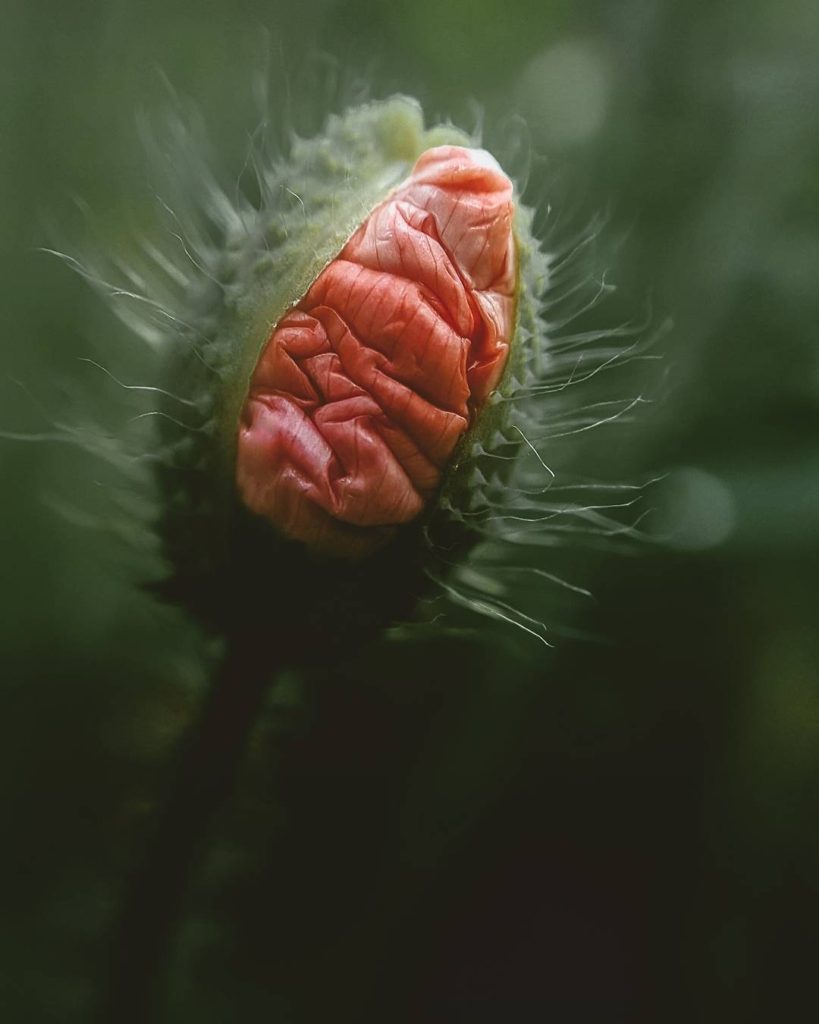
The Alien – A beautiful poppy, so creepy up close.
My next lesson is how to do street photography. It helps to only have my phone. It doesn’t feel as intrusive when I sneak up on people.
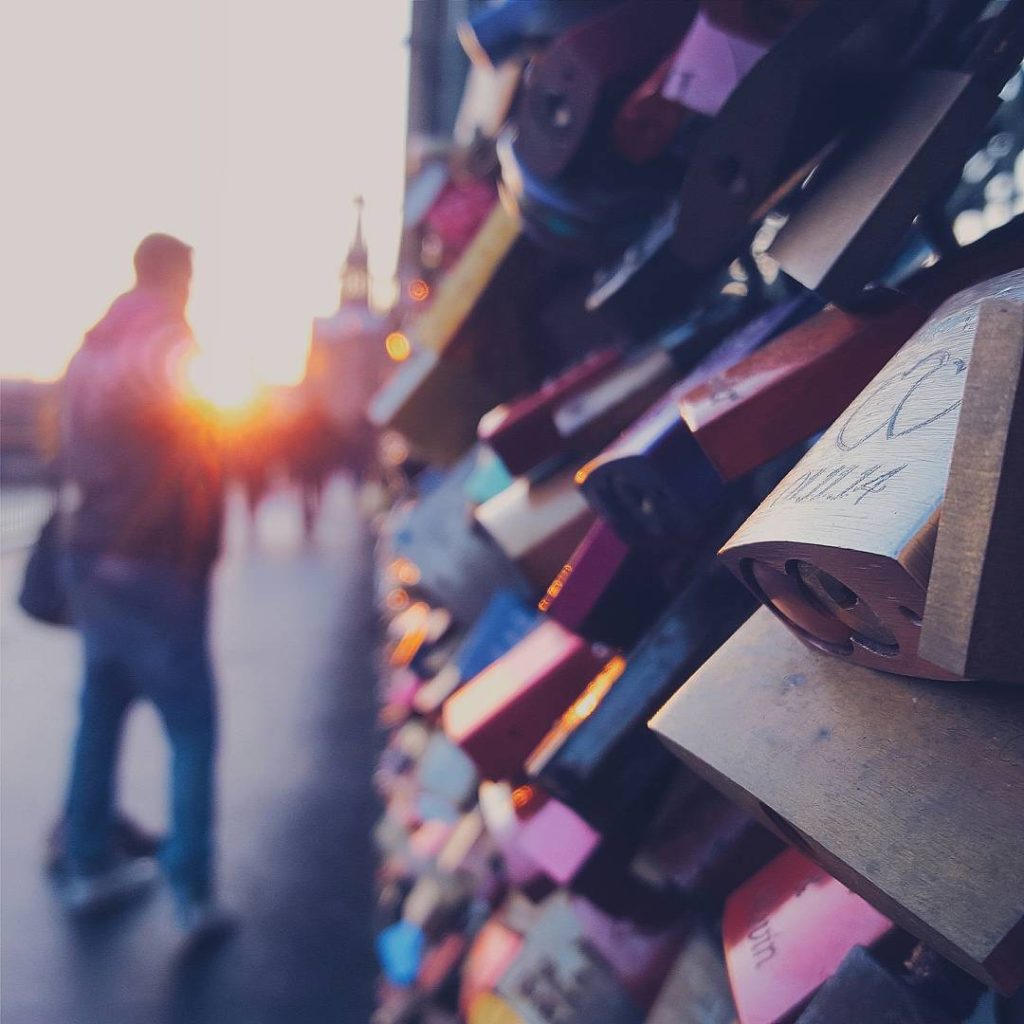
Lovers on the love lock bridge in Cologne
There is still a long way to go before I master those intense portraits taken on a train or in a café. Let’s have a talk about your friendship with your phone or how to tackle those little photo geek insecurities. Find me on Instagram @tonivisual and say hello!
Thank you, Alexandra, for editing! @whisper_feather
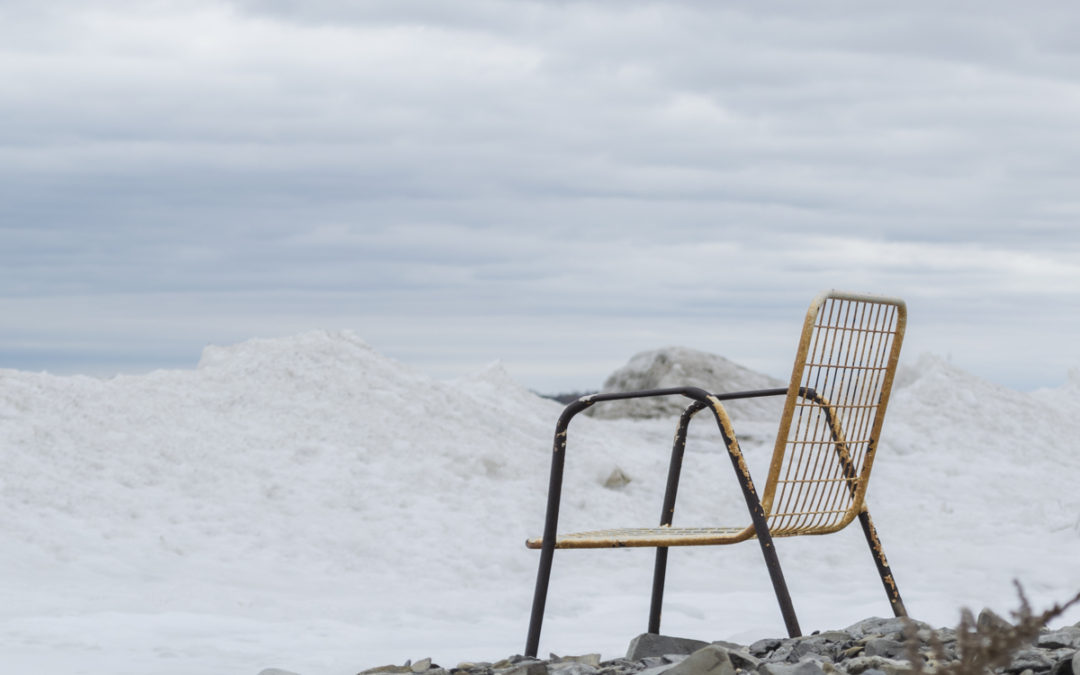
by David Brandy | Jul 3, 2017 | David Brandy, Still Life, Stories, Storyteller, You Are Grryo
What you are about to read are disparate and fictional short stories I have written to coincide with images that are part of a series of photographs of mine entitled “Empty Seats”. The series embraces the enigma of everyday objects that are specifically created by and for human beings, yet they are filled with emptiness, loneliness and a longing for human presence…

Alone and abandoned, the once proud turquoise chair finds itself frozen by the side of the road. Mere hours earlier the chair had enjoyed a life of abandoned inclusion in the warm garage of a lakeside vacation home owned by a caring family. Strategically placed next to the riding mower and directly across from the red 10-drawer tool chest, this once elegant and much sought after chaise was complacently secure in its retirement inside the cozy dry garage.
On a frigid January day with no forewarning, the teenage children from the family burst into the garage with orders to clean it out. One by one, the familiar items in the garage were carted out by the teens and left indignantly at the end of the driveway in a heap of despair. When the eldest daughter picked up the turquoise chair, it knew the end was near and its destiny would be on top of the heap on the driveway to await a final resting place in the local landfill. But all of a sudden the girl walked across the driveway to the side of the icy road in front of the property and plunked the chair into the snow bank.
Alone and facing the elements for the first time in its storied life, the chair sunk into the wet, damp snow and sighed a deep, remorseful sigh, knowing that for now it had been saved from imminent death, but, that from this moment forward, life as it had known it would succumb to a daily ritual of growing rot, mold and mildew. The horror. The horror.

William sat alone mourning his dead wife for nearly an hour. Looking up, he realized that every person who had come to witness the burial had vanished. Suddenly he felt the weight of knowing that he was truly alone now for the first time in 36 years. He rose sobbing and walked away, leaving behind a hard damp bench, a haunting headstone and the cold lifeless body of his beloved Jacqueline, now six feet under ground.

It was not always an “art piece”.
It first held court upon the front deck of a beautiful cottage situated high above a lake. Sturdy and strong with a brilliant coating of white paint, it beckoned family members and newcomers alike to sit in comfort on its reclining seat with big wide arm rests and gaze upon the magnificent view.
But time and the elements are not kind to a Muskoka chair. Today it sits on the slope that faces the lake below the cottage deck. It is in the perfect spot to be seen by those passing by in a boat or lazing carefree on the dock.
This chair comes from a strong breed. In its retirement it may be willing to sit alone in the cool shade of a Hemlock tree all summer or hibernate throughout the winter under a blanket of snow, but it is far from the end of its life. It can no longer support the full weight of today’s generation of cottage-goers, but it can support the weight of their fond memories.
After all, art is all about memories.

Derek forgot his raincoat and gloves – again!
This is a frequent occurrence – too frequent. In fact, Derek has been forgetting a lot of things lately. His doctor has hinted at early-onset dementia. But at 53 years old, Derek doesn’t want to hear about such things. After all, as he said to his doctor, “I have a wife and two daughters to take care of for Christ’s sake!”
Derek has worked at the scrap iron yard since he was 18 years old. He never saw the point in going to university. He wanted to start making money at an honest job right out of high school.
Eating his lunch at the company picnic table every day for 35 years is one of the small pleasures in Derek’s life. He loves to sit out there rain or shine. It makes him feel alive. If he happened to have left his raincoat on the bench again, so be it. He’ll grab it tomorrow, if he remembers.
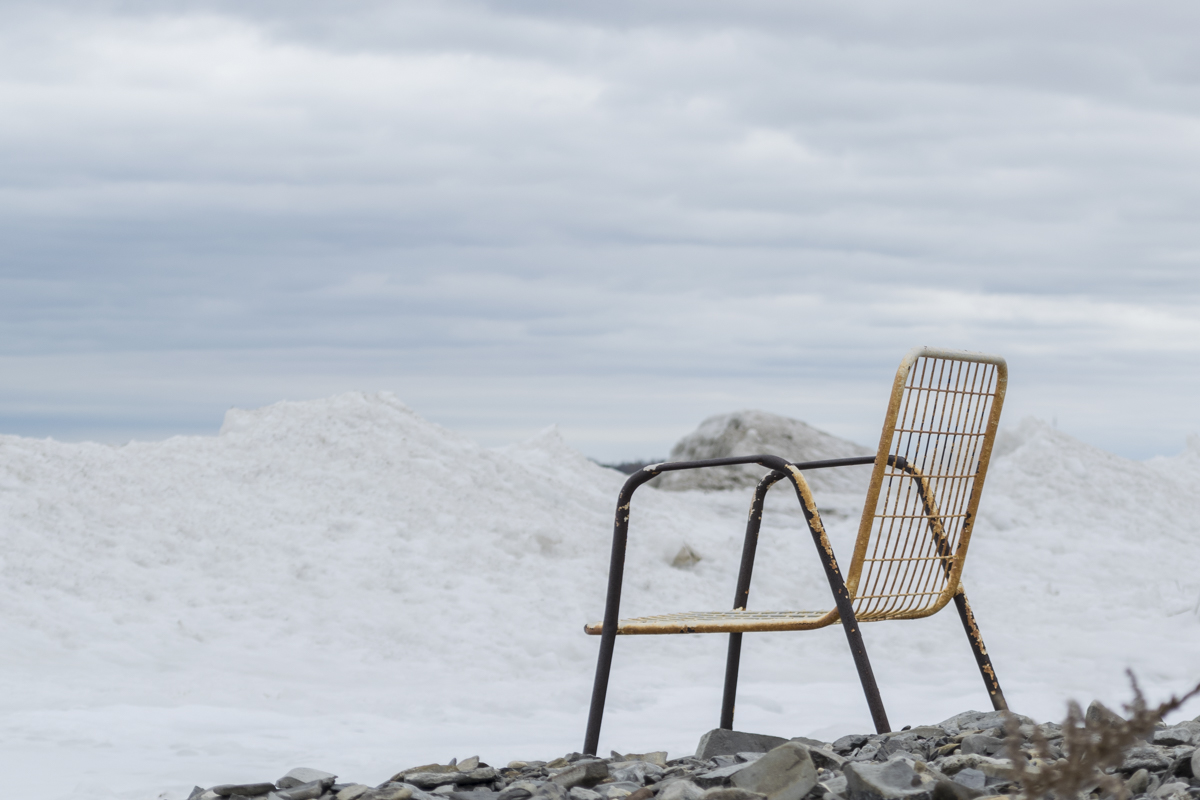
Nathalie came upon this oddly placed chair on a brisk winter’s day. It was just sitting there upon the rocks inviting her to take a break from walking her dog. “How wonderful,” Nathalie thought. “I could use a short rest.”
Nathalie sat down on the cold steel bars of the chair. At first it was a welcome respite. “Life is good,” she said out loud for no one to hear. The view was spectacular. Large ice dunes had formed along the beach and provided a scenic panorama. The sky was painterly in its glorious blue-gray striations. The air was fresh and clear. No sound could be heard except the lapping of the waves under the ice and the breathing of her tired old dog.
Then the cold hard reality hit her. A pair of thin blue jeans was the only thing that separated Nathalie’s butt from the cold hard steel. Immediately her respite was interrupted as she realized her moment of Zen was going to leave a mark!
Hoping no one was watching, she rubbed her hands across the ridges of the grid-like imprint on her frozen behind. She called her dog and briskly walked toward her car, murmuring under her breath, “Damn winter!”

Drenched and near death, men, women and children from a land far away washed up on the shore one by one, clinging to their precious life rings. Stumbling upon the beach they realized they had survived their flight from genocide in their homeland and that they were now miraculously safe.
Many of their friends and family members were not so lucky. They were not able to find a life ring to cling to as their small boat capsized in the stormy and frigid water. They were now lost forever.
The survivors who made it to this desolate beach took a moment to stack their “life” rings next to the empty benches on the frozen sand. They created a makeshift memorial to honour those who died trying to reach freedom. For this exhausted and frightened group of refugees it was of paramount importance in their dire moment of survival to somehow pay tribute to their lost loved ones.
They turned and walked away into the warm and open arms of those who would help them begin a new life in a new land.

The greatest Luchador in all of Mexico has hung up his mask. He was always a bit of a swinger.

The train came to a stop at Broadview Station. When the man sitting across from me got up to leave the train he crumpled up the newspaper he was reading and dropped it on the floor. As the man exited the train, I noticed the word “hate” in the headline on the page facing me.
“You know what I hate?” I thought. “I hate litter!”
No, wait, I hate the act of people littering. Yes, “hate” is a strong word. In my opinion those who litter deserve to have a strong word thrown at them.
Subway litter. Roadside litter. Sidewalk litter. Litter in the countryside. Litter on the beach. Litter in our lakes, rivers and oceans.
Today litter is everywhere on this Earth and it’s repugnant to me. It’s the ultimate sign of utter laziness in a human being. And it’s ignorant as well. The person who litters is blatantly saying, “I don’t give a crap about this Earth.”
Well I do give a crap about our Earth. I care deeply about stewardship and preserving the only land and water we have to live upon. We are choking it and I don’t believe it can come up for air any longer without some emergency measures. We need to release the Earth from the chokeholds of litter and pollution.
We need to “hate” litter and the actions of those who create it.

I was walking through my neighbourhood park that contains one lone blue bench. I saw a photographer hurrying to set up his camera and tripod across from the bench, as the sky grew ever darker with ominous storm clouds overhead.
Two teenage boys came walking across the park toward the bench, unseen by the photographer who was looking through his viewfinder.
The two boys looked to be up to no good, so I hung close by in case there was trouble brewing. They approached the photographer and one of them said, “Hey dude, you gonna be long ‘cause we wanna sit on the bench?”
The photographer looked up and said, “Just give me ten minutes please. I drove for an hour to get here to get this shot.”
“Are you kidding me?” the boy said. “You drove an hour to take a picture of that!”
“Ya, I did.” said the photographer.
“What a waste of time.” the boy replied.
I laughed out loud and walked away as the photographer hurried to get his shots. The boys wandered off to sit on a large boulder in the park and as I walked past them they lit up a joint. I turned to look back when I heard the photographer shout to the boys, “It’s all yours now guys.”
The boys never moved off the rock.

He had been officially “homeless” for nearly a year. This outdoor encampment perched next to an abandoned railway track was his “home” now. It contains a tarp to sleep under, a cane chair, an end table and a tiny garden with kitschy decorations.
His kingdom is deliberately designed and immaculately ingenious. The squatter got up out of the chair, grabbed one of the many pairs of work gloves he had collected and walked away.
Off he went to who-knows-where. But one thing is certain. He has a place to come home to, be it ever so humble.

Where do lifeguards go in winter?
Do they fly south? Maybe they go work at a tanning salon. Or perhaps they just find an indoor pool to guard.
These brave souls whose job it is to protect us frolicking sunbathers, suddenly vanish in September not to be seen again for another nine months.
Where DO lifeguards go in winter? It’s surely one of life’s guarded mysteries.
My photographs and words can be found at:
www.davidbrandyphotography.com
Instagram: @davidbrandyphotography
Twitter: @dbrandyphoto
FaceBook: www.facebook.com/davidbrandyphotography
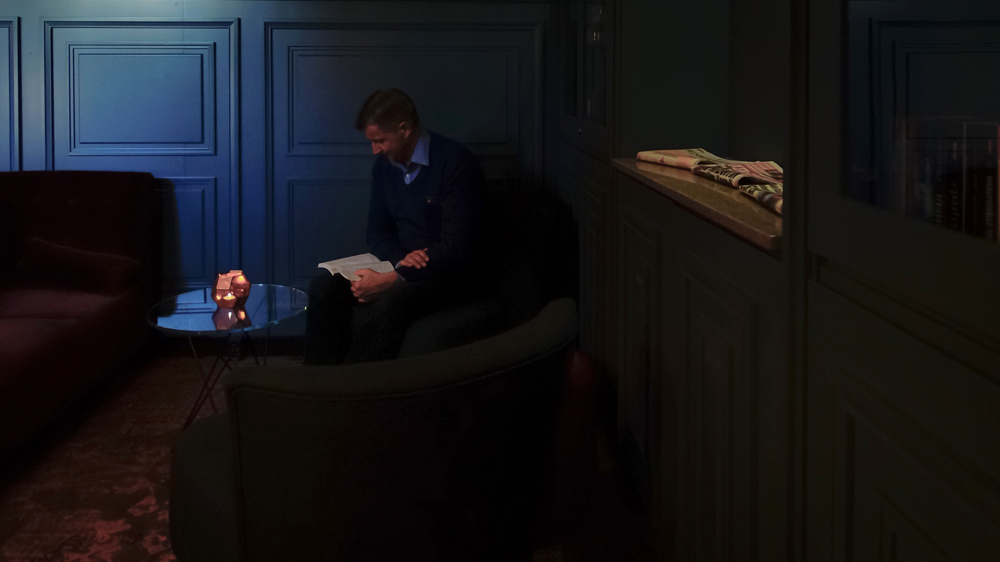
by George Pavlopoulos | Jun 23, 2017 | George Pavlopoulus, Stories, StreetPhotography, You Are Grryo
March of fears and memories. At the end of every downward road the sea appears frozen. Huge slices of ice are floating on the water like melancholic islands. Blue eerie light all day long. The wind is whipping the faces as a reminder that winter never really ends here. It’s a frozen waft that comes from somewhere far away, probably from the history of Helsinki, that cast off the despots but not the architects.

“It’s getting dark, too dark to see”
The trams, sleepy but obedient, are carrying the thickest winter coats. The seams have unraveled due to the double layer of pullovers beneath them and the eyes read the co-passengers like a book with a beginning, but without a middle or an end. Most of these thick coats are disembarking in front of Central Station, its entrance always covered by a shadow that seems amphitheatric. Doors open and close and the beggars are walking around, fishing only the bad-tempered passengers: it’s a glance of solidarity that they’re searching for, not the money in the wallet. One should spend a quarter of an hour in front of Central Station, because on that spot all the neighborhoods of Helsinki are condensing; on that spot the wrinkles on the foreheads seem like frozen railroad tracks.

“Hand in hand”
One can never really leave Central Station behind, not even when you see the buildings by Alvar Aalto and think that you’ve landed in another city. On this latitude and longitude, modern architecture resembles slices of concrete ice, which must rise above the everlasting piles of snow. The contemporary buildings are quiet in the interior: the laughter and talks of people seem to be less loud than whispers. Quite often, the voices seem to be getting distilled by the tall windows and they soon convert to light. The high heels of a woman, the keys of a guard, the crying of a baby, all that noise tends to challenge the serenity: it’s the denial to surrender in the dogmatism of walls.

“The orange balloon”
The studious visitor, the one that carries in his luggage grief but not hope, is usually jealous of the people sitting inside the cozy cafés. The windows are steamed by faces exhaling words; human snouts crouching into wide coffee pots. Aside, on tiny plates, sweets not bigger than sugar cubes present proudly themselves: they cost more than the coffee. All those underpopulated tables are becoming a cheap allegory about life up north: people diffused in a territory, trying to muzzle the weather by shutting a heavy door in its face, the same way that one is shutting his eyes in order to forget.

“Temple”
One is tripping over the threshold of the Ateneum or Kiasma museums in order to learn something that has little to do with art. In Ateneum, among sorrowful paintings hanging from black walls, a newlywed couple is shooting marital photos. A blonde woman is dragging her wedding gown on the stairs and next to her the husband is dressed in a fine suit. The photographer is chasing them on the staircase, is searching for them on the halls and is climbing on the first floor for a panoramic photo of the couple; everything is taking place among paintings that talk more about the ones that passed and less about the people left behind. An older man is staring at a painting by Albert Edelfelt, the one with the coffin of the young child on the boat; the man turns afterwards, his head towards the newlyweds. He doesn’t applaud nor disdain them: he seems to be playing a match of chess in his head, where destinies of happiness and sorrow battle against each other. If, one has to judge by his gaze, the grim version of the destiny is leading.

“Shadows are falling”
Whatever can’t be easily controlled is often getting drowned in a glass of alcohol. In the city’s market-halls, where the wooden kiosks stand next to each other selling fish, cheese and souvenirs, the locals anchor in the tables for a glass of Jaloviina. It’s a strong drink that burns the innards and fires up the talk. At the port’s market-hall, most of the people sit next to the windows and cover themselves with blankets that look like sheepskin. They stare at the little ferry that returns back from Suomenlinna, panting in the frozen sea. The glasses are getting a refill every now and then and the view of the six little islands doesn’t cause any feeling of security: the old fortress has become an outdoor museum.

“One step at a time”
The sea is everywhere. Once in a while, somewhere ashore, somebody is exiting a steaming building and runs towards the sea. He or she is half naked and is holding a towel. A dive for a couple of seconds into the cold sea and then the person runs back inside again. The less courageous prefer to stay away from the sea and they just sit on the chairs outside of the sauna. They return two, three times inside the steaming building and they repeat the ritual as if this is a ceremony of purification. It’s a siesta that has to be done with eyes wide open and the body suffers without tears.

“No surrender”
March of fears and memories. Up here, on the frozen north, the spring has been waiting for months around the corner, that overrated season of the year that always arrives triumphant and merciless. A long winter is trying to stay behind; all that silver light of the snow is the deepest version of darkness. One is visiting Helsinki in order to embark, sooner or later, in the northernmost metro of the world. The underground itineraries are never too distant, but they resemble journeys under the skin. The metro stations seem to be built on the stomach of eternal rocks and the itineraries carry on endlessly. But there comes, after all, one day that the passenger is emerging on the surface. The sun has gained some courage and appears finally in the sky while the trees are wearing their leaves again. It’s an almost violent moment, which romanticism falsely taught us to assume as peaceful. Whatever emerges then on the surface is just buried fears and memories marching on together.

“Ice reflections”
The doors of the market-halls remain open and the windows of the cafés are not steamed anymore. People avoid museums. They prefer to stand on the piers of the city, where both small and big boats are getting ready for shorter or longer journeys. A man and a woman are embarking on a vessel. They are still young and they put a basket between them. They are going to Suomenlinna in order to stretch a tablecloth on the ground and clink their wine glasses. A person they loved passed earlier this spring. They are going to the old fortress to talk, to get emotional, to laugh and to stare at the city from afar. Meanwhile, the people left behind on the piers of Helsinki are observing the scene and turn into potential painters. The shorter journeys are for the boats; the longer ones, for the people.

“A distant farewell”

“The future islands”
THE END

by Paul Yan | Jun 17, 2017 | Grryo Picwant, Paul Yan, Stories, StreetPhotography, You Are Grryo
Building up a sense of connection with Beijing through the iPhone lens – by Paul Yan
It is one thing to live and work in a city of another land other than the motherland you were born in; it is another to get used to and be in peace with it even though you have lived there for ten years. Here’s my story of how I gradually developed a sense of connection with the city of Beijing through the act of photography, which is non other than mobile photography.

I was born and raised in Taiwan, which has been geographically and culturally part of China since antiquity, but not idiologically, since 1949. Although the official languages of both lands are practically the same, the written forms are very different. People of Taiwan write in the traditional Chinese characters, while citizens of China write in the simplified form that was developed and finalized in the 1950s. The difference between the two is so great that it’s common that a person who is accustomed to one form doesn’t recognize the other. The differentiation can be found in many aspects of life including ethics, patterns of behavior, aesthetics and values.
I had been working in the music production industry of Taiwan since 1990 and was fortunate enough to have worked briefly in Beijing in the mid-1990s, participating in producing a few musical projects that are now lauded by the Chinese media as classics of the Chinese rock and pop music. However, I didn’t feel the need to move to China to continue my music production career as I had enough work to do in Taiwan. It was in 2005, after being encouraged and invited by my friends, that I moved to Beijing to continue my music production career. Everything had been going very well with work, I’d made many new friends and I had been supported by old and new customers. However, it was pretty hard for me to really establish a comfortable rapport with the city.
Everything changed after I started to take photographs, mainly in the street of Beijing, with my mobile phone in 2015. On my days off from long hours of studio work, I frequently went out and roamed the streets of the city for over 6 hours at a time to shoot to my heart’s delight. That became my only mode of exercise to keep me fit. I found myself opening up and chatting a lot with strangers in the street while taking photographs with them in the frames as the human elements. Sometimes environmental portraits are made after brief conversations with my human subjects. Being mindful of the happenings in the streets and parks, feeling the heartbeat of the city, I began to build up a real sense of connection and belonging through the act of mobile photography.
It’s a splendid myth that the act of mobile photography has brought me closer to the soul of the city of Beijing after living in it for ten years.

[Smoke on the Cluster]
You can find roadside Barbecue stalls everywhere in Beijing, and all over the country, when the climate is warm enough. Roadside BBQ is a major pastime for the people in the evening; you can smell the smoke and scent from afar. Upon seeing this stall, I asked the chef if I could photograph him working – he was totally cool in front of the lens. My right hand almost got burned while taking this one as I was holding my phone very close to the grill while he was sprinkling spice over the clusters of mutton.

[The Day After]
After kissing my mother goodbye at Beijing airport, I decided to stick around outside the airport building to take advantage of the overpass under which people would walk by. I pre-focused on the floor a few meters in front of me, held my phone right on the floor to get the composition and then waited, squatting… A couple of minutes later, this lady walked by and I released the shutter with the phone’s ear-buds cable as she just got into the frame walking in full stride. Thanks to her curiosity about what I was doing, she glanced my way over her shoulder while the photo was shot.

[A Stroll with Siddhāttha]
Early winter morning stroll in the woods, I felt peace and imagined walking behind Mr. Siddhāttha Gōtama, aka the Buddha (the Awakened One) – listening to him teaching me how I could practice to be free from all attachments to ego and everything. This was shot with the Slow Shutter Cam app in Motion Blur mode, focus-locked on the nearest tree, scanning the phone vertically to achieve that blur.

[Progressive, in Raving Lights]
A photographic tribute to all the classic progressive rock bands like Yes, King Crimson, Genesis, Rush and Marillion, etc.. This was shot on an overpass with the Procamera app set to 1/2 second at ISO 32. I focused on the floor and wiggled my phone vigorously when these people walked into the frame to take the image. The light streaks were headlights and tail lights of passing cars.

[Tread the Path]
I was experimenting here, taking low-angle shots with the Manfrotto Wide-Angle add-on lens. After locking the focus on the ground in front of me. I set the shutter speed and ISO in the ProCamera app in my iPhone 6 Plus, then squatted on the edge of the pavement by the boulevard leading to Tian-An-Men Square in Beijing and waited for my prey. I had the top edge of my phone right on the pavement and tilted the lens up towards the low afternoon sun with the intention of including only someone’s legs in the frame. I saw a man coming by while another was in the distance. The shutter was fired when the one near me was about to walk out of the frame and the one in the distance was right in the triangle formed by the former’s stride.

[Kalyāna-Mitra – Lesson from a Tree]
This tree, among others, has always been erect on the bank across the small river close to where I live, and can be see from my balcony every day. It changes from being leafy to bare and the cycle goes on through all the seasons. It has become one of my friends in nature and has been a living reminder to me of the lesson of impermanence and equanimity in all conditions. It’s my “Bodhi Tree” if you like. One day, I decided to shoot a photo of us two together…

[Into the Unknown]
I was strolling in the eastern downtown area of Beijing one afternoon when I came upon this entrance/exit of a subway station. An escalator connected the station to the ground level where a translucent blue canopy had been installed. Refracted blue light fell on the walls and the ceiling inside the tunnel, rendering the people on the escalator as silhouettes against a blue background, when one looked up from below. The words “twilight zone” came to mind when the scene met the eyes.

[Crossfire in the Jungle]
This image was taken at a crossroads in Beijing, where cars honk their horns relentlessly at everything in front of them, right at the instant when the traffic lights go green. Life in the urban jungle isn’t so easy for a lady, especially when you’re threatened by carnivores on wheels that don’t know pedestrians are to be respected.

[Ascent to Luminescence]
Me and my wife were visiting a friend who was a professor at medical school. This stairwell was just outside his office. I thought the profile of the stairwell wall, when looked down from the upper level, was geometrically interesting for a photograph… but not that interesting without a person in the frame. So I had my wife go down to the level below and asked her to go up with her hand on the rail. I took the photograph while she reached the spot that I’d pre-visualized for the composition. Thanks to my lovely wife for her co-operation!

[Hey babe, take a walk on the wild side!]
Shot on a rainy night outside the entrance of a supermarket near home. I saw the wet pavement reflecting the red light emitted by the neon sign above the storefront and thought it would make good foreground for an image. A girl walked into the frame pretty soon. My lips pressed one of the volume buttons of the phone’s earphone cable to fire the shot, right when her legs were in wide stride in front of the bright store light.

[Up is the way!]
I was wandering around a bus station one afternoon when I hit this spot under an overpass where a triangle was formed by the columns and the edge of the overpass. Without hesitation, I focused on the stairway, carefully composing the scene so that the top tip of the triangle touched the top edge of the frame, and waited for my prey to get on the stairway.

[Mama told me not to come!]
It was in a lovely August afternoon last year when this photograph was taken. A few kids were playing and running around in an open area of a park, and the pinky dress and shoes of this jolly little girl attracted my eyes immediately. I pre-focused on the ground about 1.5 meters in front of me, squatted and waited for her to run past me, and she did!
Viva innocence and purity!

[Universal Fountain of Love]
At the fountain in the frontal plaza of the Hyatt Hotel in Beijing, which was pretty close to the Royal Palace/Forbidden City/Tian-An-Men Square. The fountain was lit from inside the rim around which people like to take selfies or pictures of their family and friends. The plaza is usually swarming with people in the evening so it can be hard to take a clean photograph of the fountain.
The girl in the frame had just finished posing for her friend’s smartphone on the rim of the fountain and was bending down to pick up her purse, getting ready to leave when I took this photo.

[Nothing Lasts Forever]
The city of Beijing had a pretty heavy snowfall on November 22nd 2015. I was delighted because I had been hoping for the advent of snow so I could go out and have some fun shooting in it. My white trip started at about three in the afternoon. I had already been rewarded with a couple of worthy frames when patrolling in the wafting snow before this image was taken. The snow on the branches of this tree by the river, along with the snow on the surrounding ground, were tinted electric pink by the row of red neon signs on the other side of the road. I put my iPhone on a tripod and set it up about 3 meters from the tree and half a meter above ground. I angled it up approximately 30 degrees so I could have the tree, with its hanging leaves, as a natural frame that partially veiled the residential buildings across the steaming river.
The sun had completely set when I began working on this image. To have the ISO value as low as possible to avoid noise and grain, I set the shutter speed of my ProCamera app to the slowest it could go: 1/2 second, and I had to set the ISO to no lower than 160 before under-exposure was inevitable. I left the auto white balance on as the colour temperature decided by the app was quite spot-on on this occasion. The app’s self-timer was set to 25 seconds, giving me time to get into position in the frame, playing the human element.
This image, as a self-portrait, conveys my state of mind at the moment:
Steam on the water, snow on the ground, leaves on a tree, smoke from a cigarette, man in an overcoat – all conditioned things are but fleeting existence. Nothing lasts forever. So don’t be attached whatsoever.
May all be in peace and joy!
Paul Yan is a talented photographer and Picker. He is the first author to be published on Grryo following the announcement of our partnership with Picwant.
See more of Paul on : Instagram | Interview video on YouTube
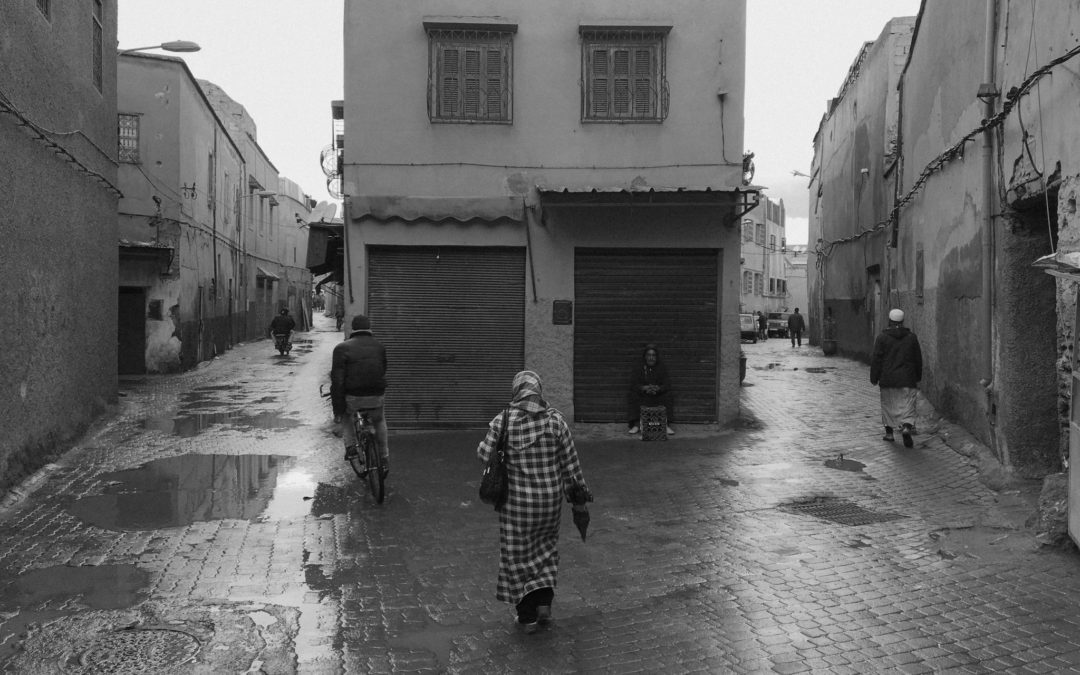
by Alexandre Kurek | Jun 9, 2017 | Alexandre Kurek, Black and White, Stories, You Are Grryo
It was almost as if the rain had washed away any traces of an identity we – the tourists, travelers, photographers, writers – gave Marrakech over the years, and had now revealed a much more accurate truth of a city usually depicted as way more colorful and exciting than it really is. But not that day. Gone were the beautiful and rich colors – and smells of various spices and freshly cooked foods usually experienced in Marrakech. Instead, I was witness to a grey and flavorless, almost melancholic, truth of the so-called red city – unfolding a deeper drama of mundane life right in front of me and thus catching my deepest interest.

Wandering through almost deserted streets, I was able to catch a glimpse of a reality totally concealed to most of the foreign visiting public, a reality filled with boredom and uselessness – there was no need for artificial excitement for there were simply no tourists present who had to be artificially kept excited. The only people around, despite a few stray visitors like myself, were Moroccans going their way or hiding from rain underneath a canopy, in shops or by a door, and alleyways, minding their own business. I met Nick at Café de France later that day. After being separated from each other for a couple of hours – we decided to part ways for some time in order to be able to focus on taking photographs without distracting one another – we sat down to drink a coffee and have a talk on the roofed balcony only minutes before a heavy rainstorm hit us. As the people seated in the front row of the balcony started fleeing from the fierce rain, Nick and I – seated in the much safer back row – were rewarded with an excellent view of the usually heavily populated Jemaa El Fna square.

We watched in awe as the storm got heavier, several lightning strikes occurred and people all over the square ran around seeking shelter. The sky cleared up and the storm ended just as fast as it had begun, and we continued our journey through Marrakech together. Drawn to a crowd of people standing in front of a huge but unobtrusive building, right next to the Maison de la Photographie – which we just visited – we decided to stick around and observe the scene for a little while. It quickly turned out that this building was in fact an elementary school about to end classes, and soon the people in front of it were greeted by dozens of children rushing out of the school screaming, chanting and laughing – young lives invigorating the lifeless streets again.

Quickly backing off to an opposite wall while joyfully watching the kids being hugged by their benevolent mothers and fathers, I looked around and noticed five to six men approaching really fast, carrying a gurney loaded with something unidentifiable, covered up only by a white sheet. Seemingly unnoticed by the parents – there was just too much commotion going on – the men slowed down while shouting and simultaneously pushing their way through the crowd. Catching a glimpse of what was hidden beneath the sheet, it was then I realized that they had loaded the dead body of a young boy onto a bier, carrying him as fast as they could through the narrow streets of Marrakech to whatever their final destination was. A man who stood right next to me – and one of the very few having noticed the load too – told me in french that he had heard about the recent tragedy of a young boy being struck by a speeding car, not far away from the very school he and other parents were standing in front of, eagerly waiting to pick up their children. “Il est mort,“ he said with a toned down voice, and sounded certain about that young boy’s fate. “They are rushing him to a nearby hospital, but it’s already too late. He’s dead. It happens a lot around here. People are getting hit by cars almost every day. It is horrible. You just can not be careful enough,“ he continued, shortly before embracing his son and with him vanishing hand in hand around the corner.

Pictures of Marrakech – and Morocco in general – usually show us only the sunny days, the vivid markets, the tasty food, the carefully prepped up tourist attractions of the Medina, the architecture, smiling elderly people, cats and donkeys – or all sorts of things and animals – creating a wide variety of colorful and playful motives – as seen in some of my other images too. But a beautiful color palette doesn’t matter if there is no light to be shined on by it. I guess, in a way, that was the reason for me to shoot mostly in black and white that day – so Marrakech, the red city, could remain grey and sunless for a day, mourning the loss of another son.

“We like to pretend that what is public is what the real world is all about,“ Saul Leiter once said. But the truth is, there is always another world hidden beneath the obvious and purposefully displayed, a world that’s not often been photographed or recreated countless times before due to its mundane and unspectacular nature. But it is not sensationalism that drives me or that I seek in my photographs, it’s the ordinary lives of ordinary people that interests me. During that day – while aimlessly roaming through Marrakech at first – I was somehow able to catch a glimpse of exactly this reality I’m seeking and I am deeply grateful for having experienced this.
To know more about Alexandre visit him on : Website | Instagram | Tumblr
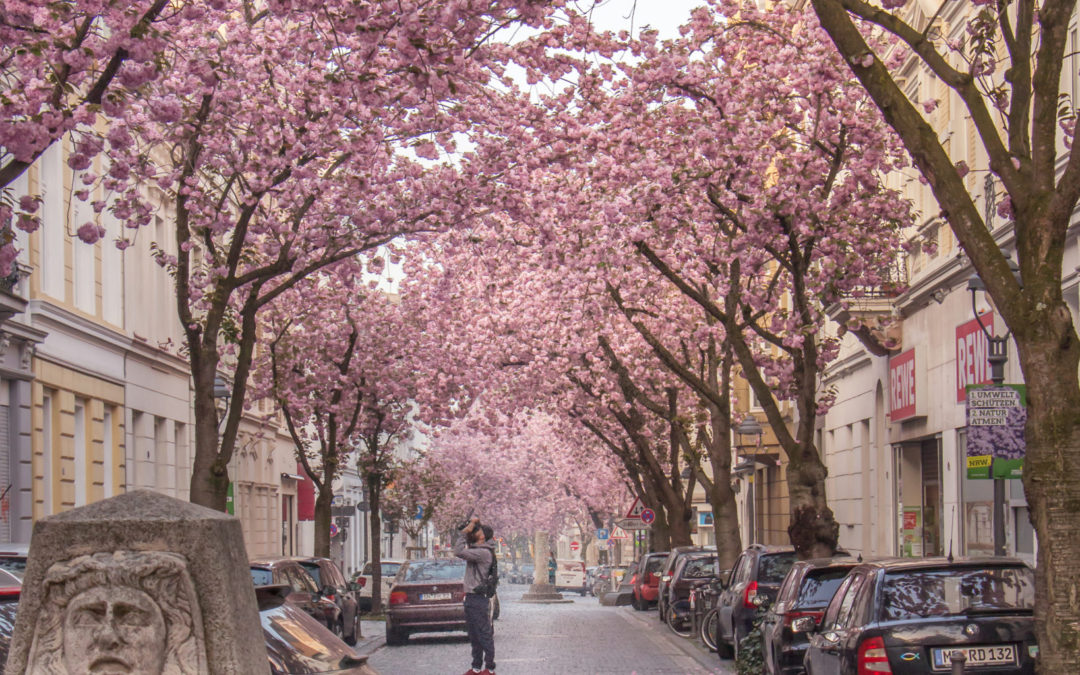
by Antonia Baedt | May 25, 2017 | Antonia Baedt, Stories, You Are Grryo
“It is spring time now! While the world looks for a new war to fight, you look for a cherry blossom to watch! Let the stupid seek violence; you seek the elegance!” Mehmet Murat ildan
The wind picks up a plastic bag from the street and swirls it into the air. The crackly noise breaks the silence; the kind of silence that only an early Sunday morning can bring in a big city like Cologne. It’s quarter past 5am, the sun hasn’t come up yet, but the sky already has that golden shimmer. I am loading my car with cookies, hot tea and of course my camera gear. Alexandra (a friend I met on Instagram) and I are going to Bonn to enjoy a very special treat. One that only lasts for a couple of days every year.
Hanami – Japanese – “the enjoyment of the beauty of flowers”. A word that is mostly used to describe the more than a thousand-year-old tradition that exists around the blooming of the sakura. The cherry tree.
In the 80s, when the city of Bonn decided to undertake major restorations in its city centre, they also planted cherry trees. Today, for a few days in April, a handful of narrow streets are dipped in pink.
I pick up Alexandra at the river Rhine. There is still a chill in the air but it is promising to be a beautiful day. We are engulfed in mist as we drive along the big river and then down the six-lane highway which, usually full of traffic jam, is now completely deserted.
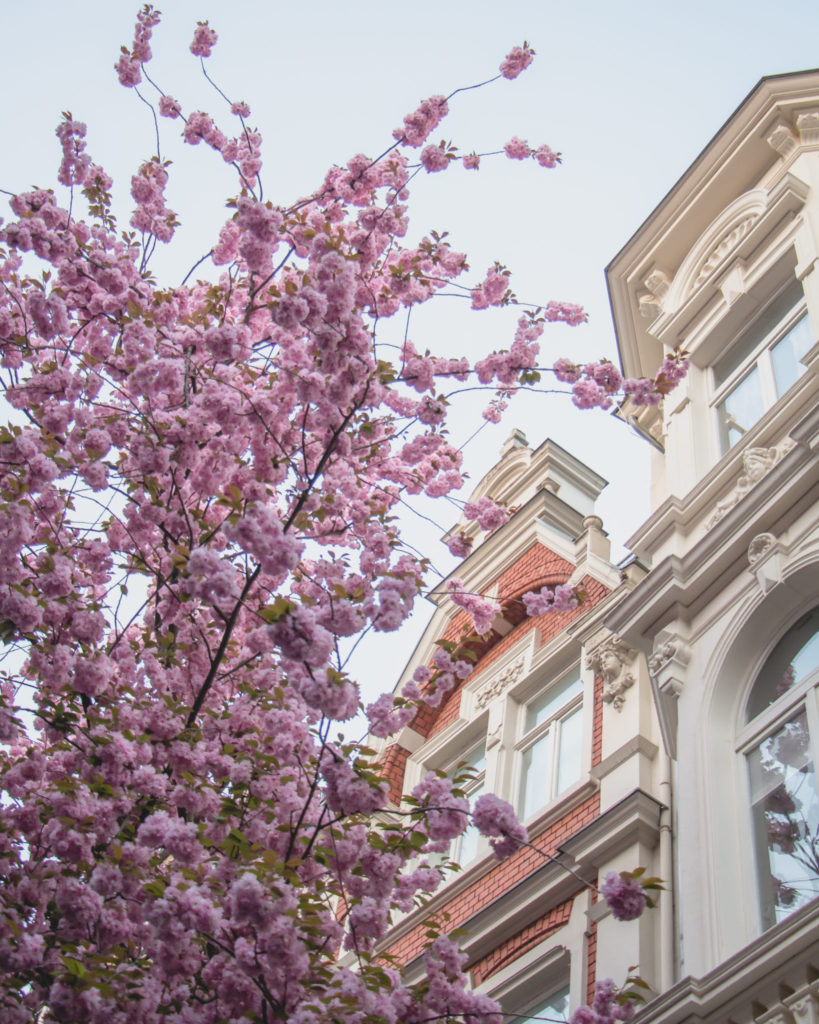
Enjoing the silence of an early sunday morning.
As we get out of the car in Bonn we are greeted by the aroma of fresh coffee. Some of the locals have opened their windows and one of them is looking down on us while we slowly make our way along the street, our heads tilted back.
The sun rises and we begin to feel its warmth. As we turn around a corner onto the main cherry-blossom-street, we almost bump into another photographer. There they are, about ten other early birds, with their tripods and big cameras.
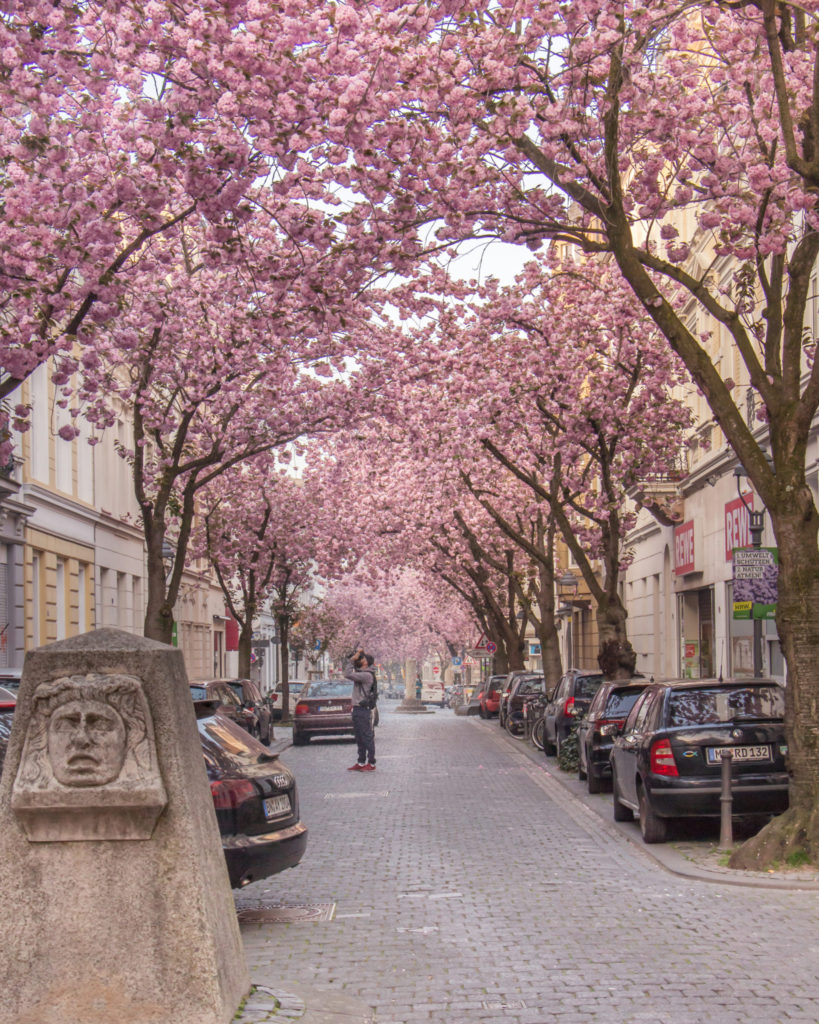
The things we do for a good photo…get up at 4am on a sunday!
I own a small DSLR camera with a standard zoom lens and a 50mm that I really like, but a lot of my pictures are still taken with my phone. I enjoy the spontaneity of it and that I have the result right there, ready to edit with an app and share it straight away if I want to. Apart from my phone, my other constant companion is a plastic bag. I get a few strange looks as I pull it out of my bag to get down on all fours into the curbstone.

#beautyiseverywhere Don’t you think?
The meaning of cherry blossoms in Japan is best summarized as a symbol of perfect beauty and the beginning of spring, a time of renewal. And then there is the fleeting nature of its life: a cherry blossom lasts only for about two weeks. It falls after a long maturity in the moment of perfected beauty.
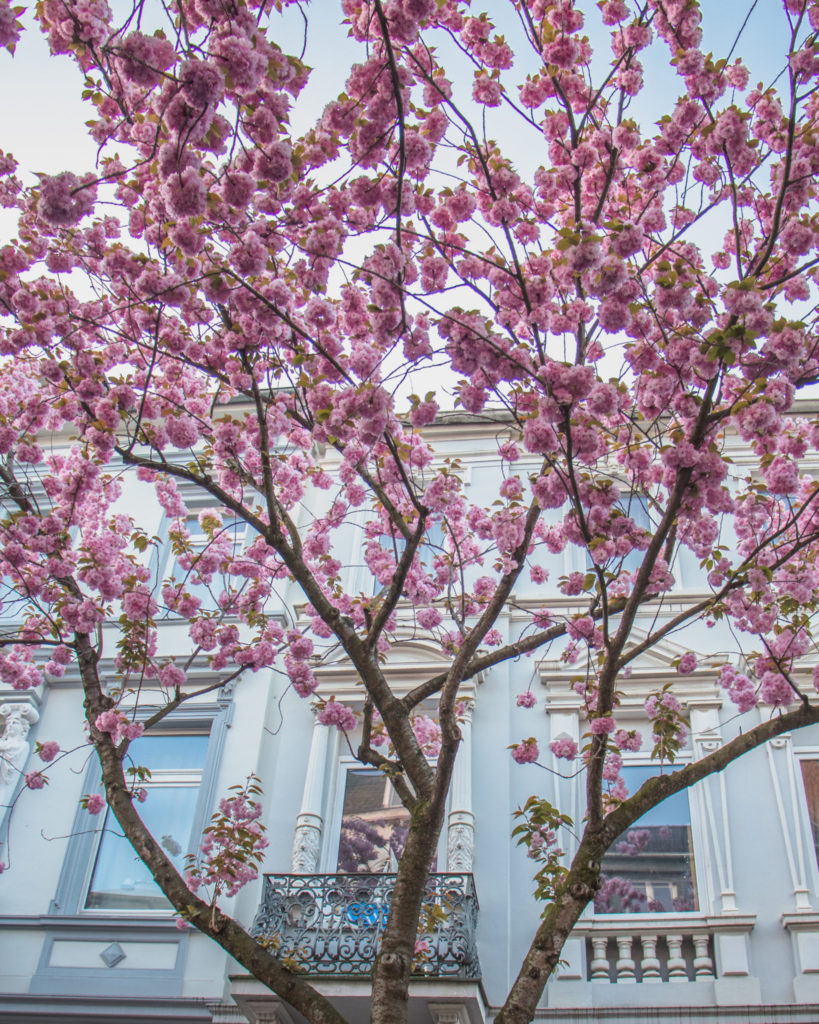
An ocean of pink in a blue sky.
The Japanese cherry trees in Bonn are not plants whose fruits can be eaten later. These are ornamental cherries with many pink flowers.
As the morning goes on, more people appear on the streets. The café owners and delivery men don’t pay much attention to us taking pictures of their trees. They are used to this madness around at this time of the year.
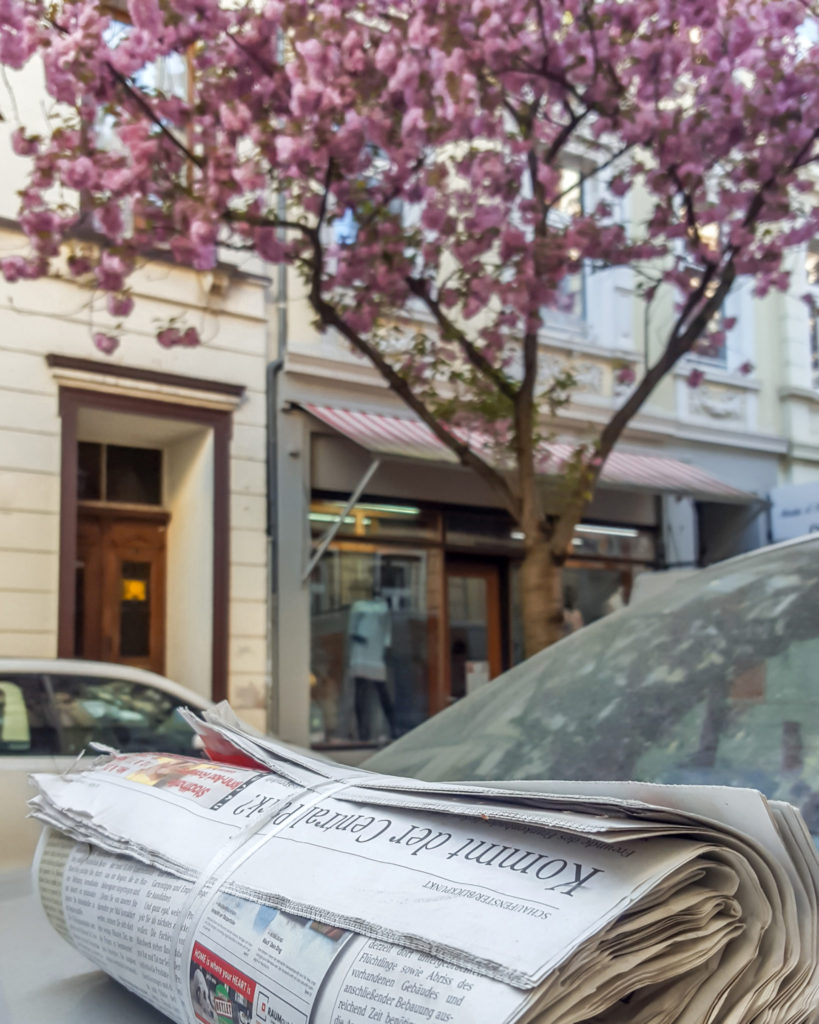
Slow living.
Alexandra tells me about her first visit here, a week earlier, on a Saturday afternoon. “It was so busy“, she says, “people were waiting in line to reach one of the few high points in order to get a clear shot of the flowerage.” Entire busloads of tourists, couples in wedding attire taking wedding pictures one month before their wedding, girls posing for their Instagram pages…
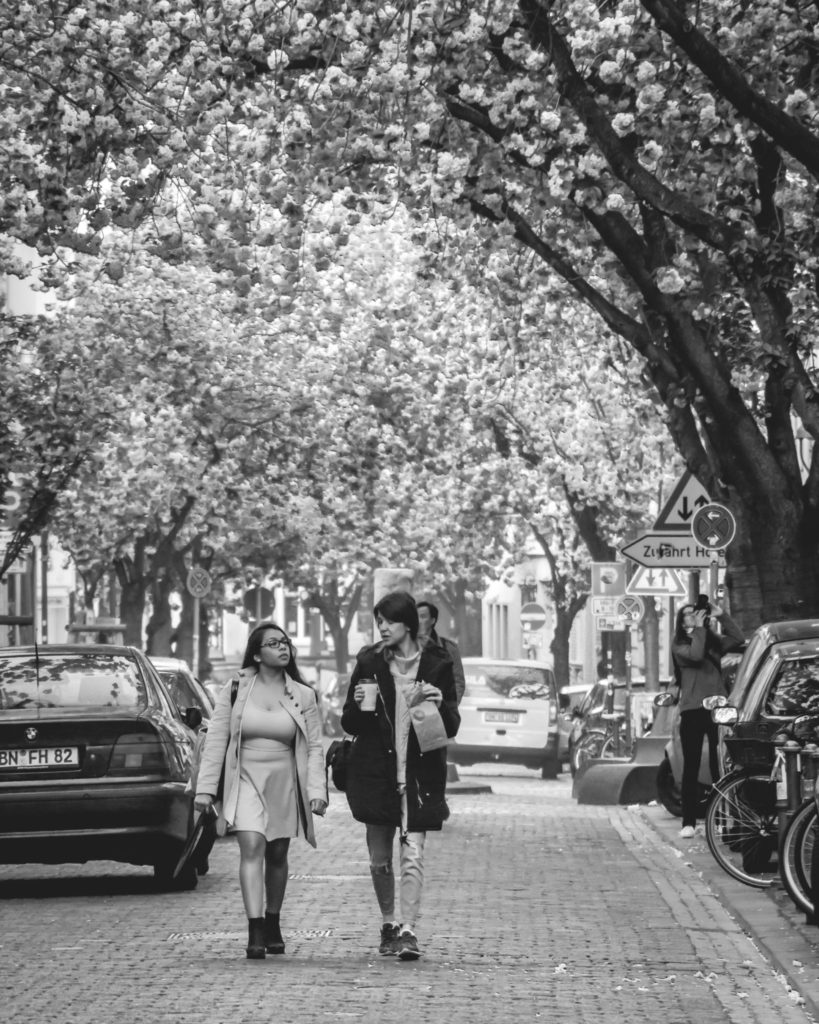
The unknown Instagramer and her photographer.
And in fact, the crowd starts to change while we continue down the street. After the bright daylight has replaced the golden sunrise, the professional photographers disappear one by one; families, groups of friends and photographers with their models fill the air with happy chatter.

We all know what this will look like in Instagram, don’t we! 😉
The occasional car scatters the crowds onto the sidewalks for only a moment. The magic of the pink tree tunnel has us all back in the middle of the road immediately.
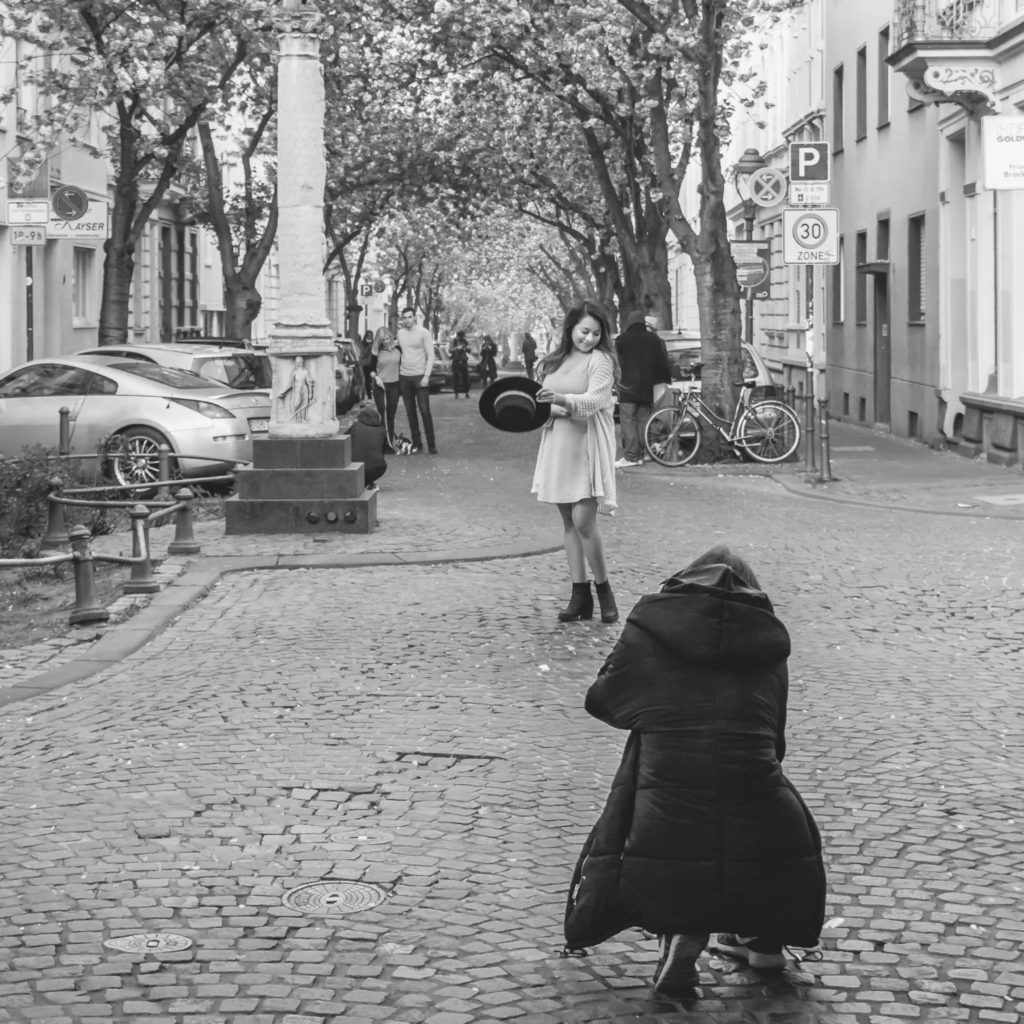
“In the cherry blossom’s shade there’s no such thing as a stranger.” Kobayashi Issa
It’s almost 10am now and my phone is about to die. Alexandra and I have walked up and down the pink streets a few times, but now it’s becoming a challenge to avoid getting caught in the different camera lenses pointed everywhere. We return to our car and head back home, leaving the cherry blossoms to the masses that will appear shortly. We will return next year.
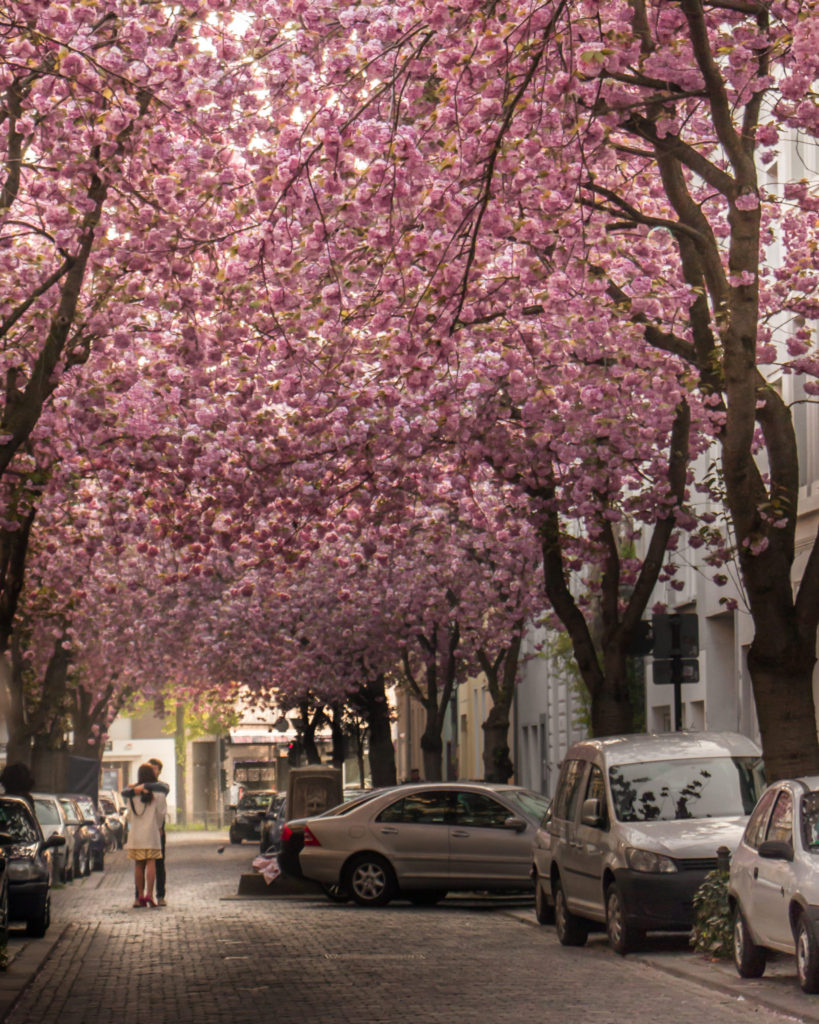
My lucky shot. I didn’t even see them before editing this picture.
“Ah, if in this world there were no such thing as cherry blossoms, perhaps then in springtime our hearts would be at peace”. Ariwara no Narihira
Thank you to my lovely friends Alexandra and Alexandra! @alexandra.loves.cologne for being my photo walk buddy and @whisper_feather for being my editor!
For more cherry blossoms in Bonn visit the IG hashtags #kibo17 and ‘kirschbluetebonn. See you around! @tonivisual

by Grryo Community | Mar 28, 2017 | Stories, Storyteller
Changing Beauty – The Changing Face of Beauty
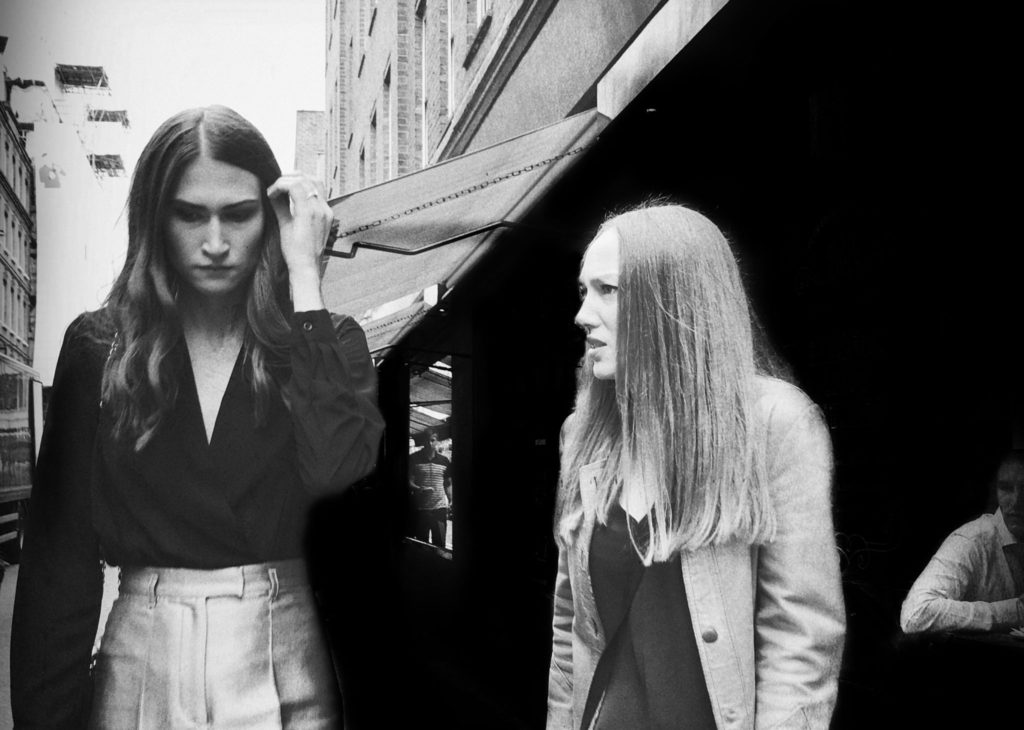
© Caroline de Bertodano
For centuries beauty was represented by natural beauties. Salome, Guinevere and Nefertiti to name but a few. Later beauty was portrayed in artworks such as Botticelli’s Spring, Rossetti’s Other Woman, da Vinci’s Mona Lisa and many Impressionist works. All evocative of something more than appearance. The Greek male nude sculptures and the female nude deities of Eastern Ishtar to the later Western art such as Donatello’s “David”, Titian’s “Venus of Urbino”, celebrated the natural human body. All to stir the mind as well as the sensual passions. Very recent depictions of beauty in art are dormant and beg the question as to why? A backlash to society’s ‘meat market’ and physical fabrications?

© Caroline de Bertodano
Through the ages, the size and shape of beauty have come and gone but natural was ever present. Different body types and features went in and out of fashion aided by the armoury of clothes and makeup but ‘natural’ was the foundation. People simply got on and appreciated more what they had been born with. In recent times, celebrity has replaced almost everything and as the avarice consumers we have become, we follow like sheep.
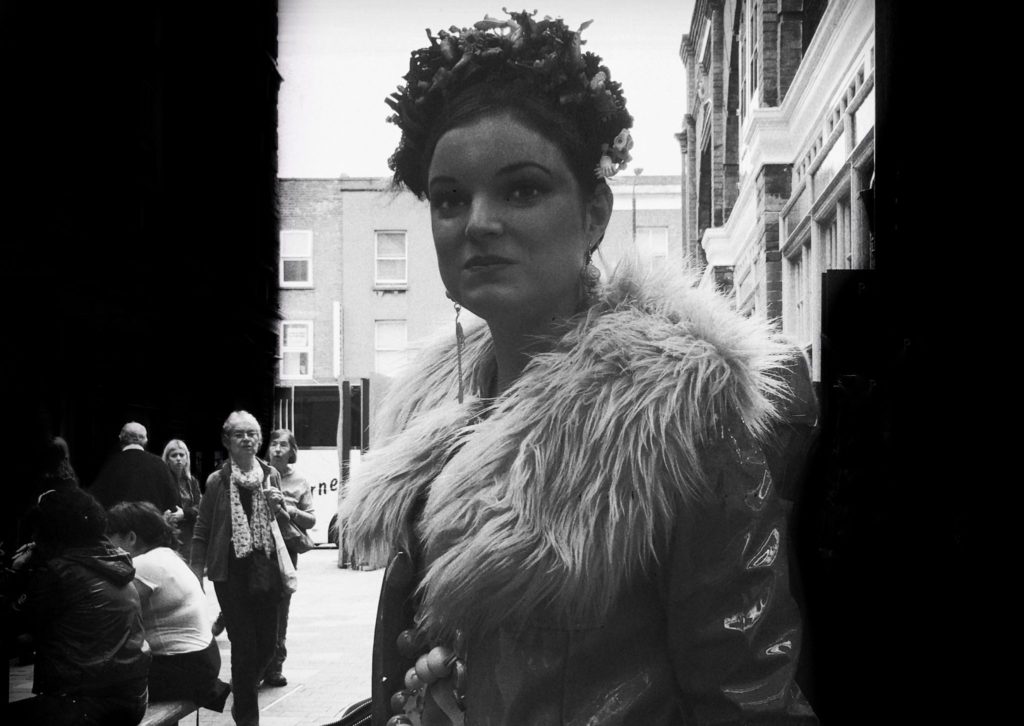
© Caroline de Bertodano
The reality of beauty, either male or female, is that almost every person is not happy in their own skin and has a list of what they feel disdain for about themselves, if not pure self-loathing by many women. An agenda of what they would change if they had the money. Massively increased depression & eating disorder numbers have the psychiatrists rewriting the psychology books. If we add ageing to the equation, what was ’50 is the new 30’ and now ’50 is the new 70′ based on looks alone. Media role models advocate nothing but shallow appearance, they negate the actual being, of being human, born natural and undoubtedly will die as bare to living as death intends. Time will always transcend the superficial.
Every age has issues of imperfection but never before to such extremes and even the 20 somethings have joined the mass hysteria in the quest for perfection and elusive eternal youth, where beauty is considered to reside. Exaggerated ideas of imperfection and the ‘fixing myself’ phrase is often heard. With the explosion of social media and its consequential hunting grounds, the idea of perfection is now so media influenced by pretense, false impressions of image, persona and of course the eternal super skinny body form…. no surprise there! Many men are taken in by these falsehoods. But in this age of ’swipe right’, they just move on to the next idea on their perfection list, wondering why they cannot find true and lasting love. Women have become competitive instead of supportive, putting good images of themselves to annoy other women or for attention that they lack in reality.
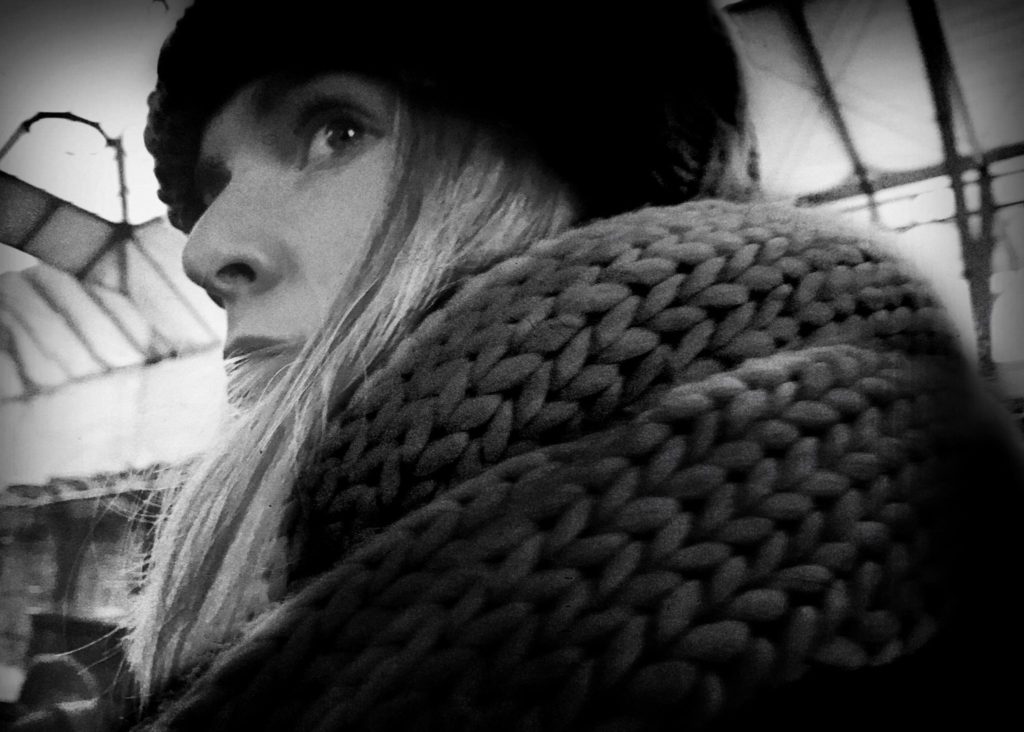
© Caroline de Bertodano
“I’d like to say that I would be happier in my natural skin but given the opportunity, I would enhance myself. It would seem silly not to. When we live in a world where celebrities and superstars are always looking amazing and we are exposed to the ideal woman and figure all the time, why wouldn’t you want to keep up? There seems to be a much higher standard of beauty… not a natural beauty but a beauty that can be made through cosmetic surgery. You only need to look at the ‘IT’ girls of now and look at a ‘before and after photo’ to realise they are doing it. It eventually just comes down to money. Money can buy physical beauty essentially and if I had the money I would be lying if I said I wouldn’t make changes to myself. Every girl has something they hate about themselves or feels self-conscious about and if it somewhat bothers you, of course, you are going to want to change that. It is not like there are any female role models advocating natural of ‘inner’ beauty but quite the opposite really; young girls are bombarded and almost brainwashed by social media about what is a normal young girl should or does actually look like”
Eva 21 years.
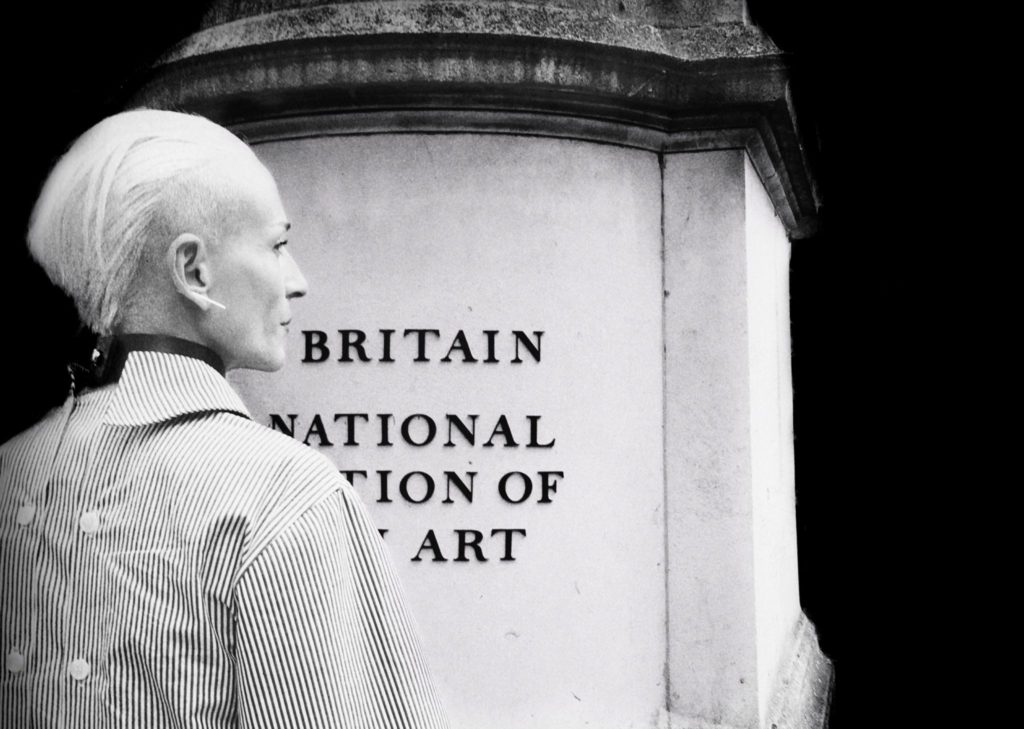
© Caroline de Bertodano
There is a chasm of difference between plastic and cosmetic surgery.
Plastic surgery is ‘reconstructive’ for medical reasons and includes, burns, limb loss, birth defects, trauma and disease and is vital, both externally & internally life-saving.
Cosmetic surgery is elective, ‘a choice’ by an individual to enhance appearance only.
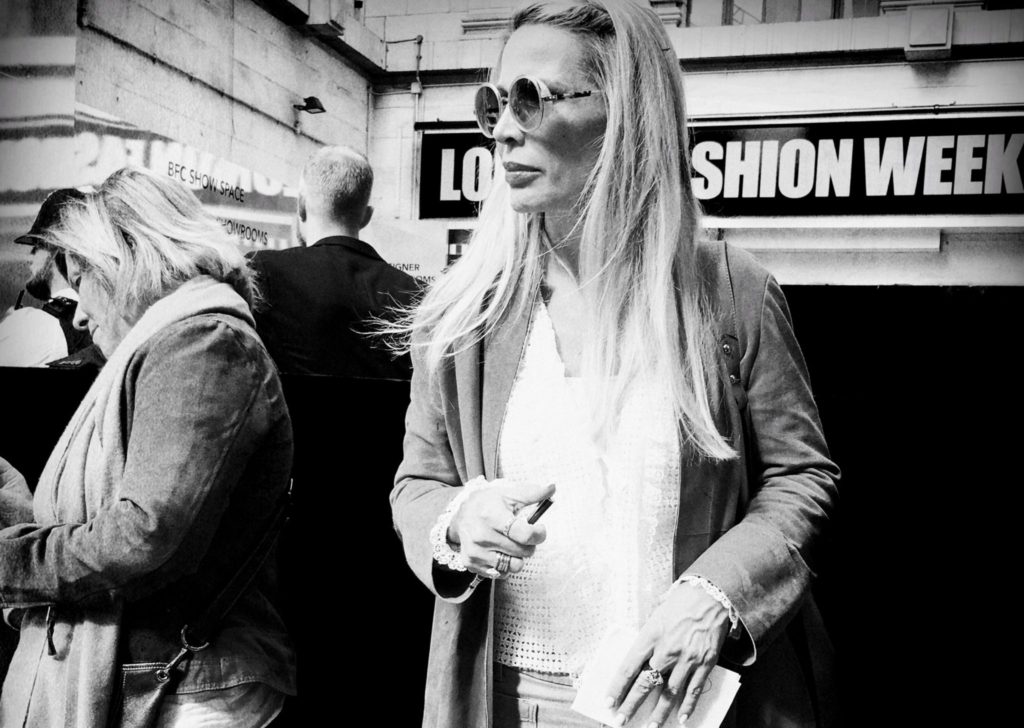
© Caroline de Bertodano
With endless procedures, media & social influence, the idea of beauty means many are starting to look alike. Some so alien from their original self they become modern day monsters as procedures ‘fall’ and they lack the money to redo them. Expressiveness and uniqueness are being lost. The expressiveness of a child’s face in laughter, the look of love, is the beauty & emotion within that is expressed externally.
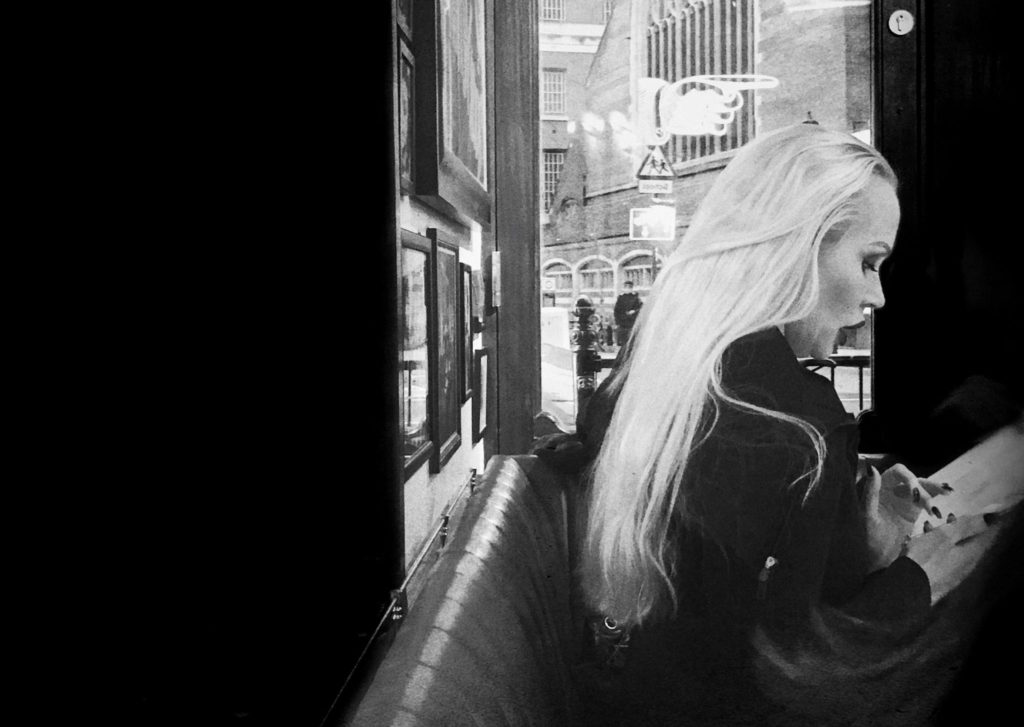
© Caroline de Bertodano
However, in some adults, they can no longer show emotion on over engineered faces, which in turn affects the emotional communication in relationships. First impressions aside, if we are all impressed by certain looks alone, the character, mind and soul; the internal self, go unconsidered and disappointment and failed relationships surely follow. Is Audrey Hepburn, one of the iconic beauty’s of our time, now ‘imperfect’? Her beauty came from what was inside as well as outside and many talk of her internal light.
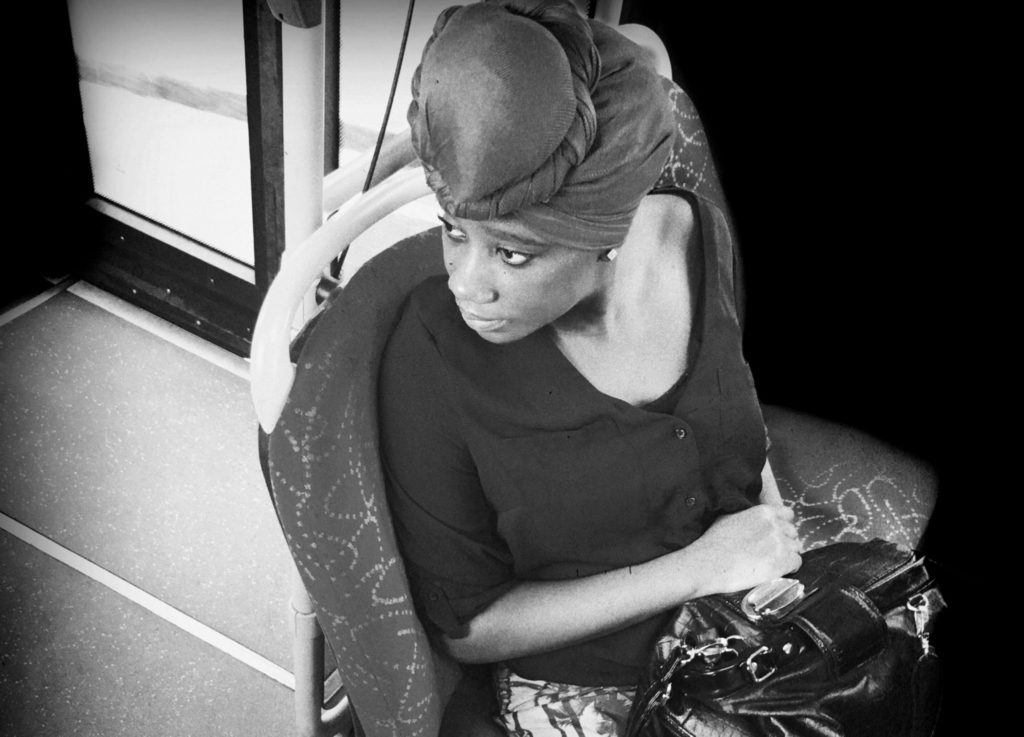
© Caroline de Bertodano
The greatest beauty is the true natural beauty requiring three vital ingredients. Looks, mind and soul. Ever fallen in love with someone you least expected to and been surprised because they are not your ‘normal type’ but because of ‘who’ they are, not just what they looked like? Imperfections pale into insignificance on realizing emotional depth, mindful heights and the confidence they generate. True beauty is the combination and what artists for centuries before us tried to depict.
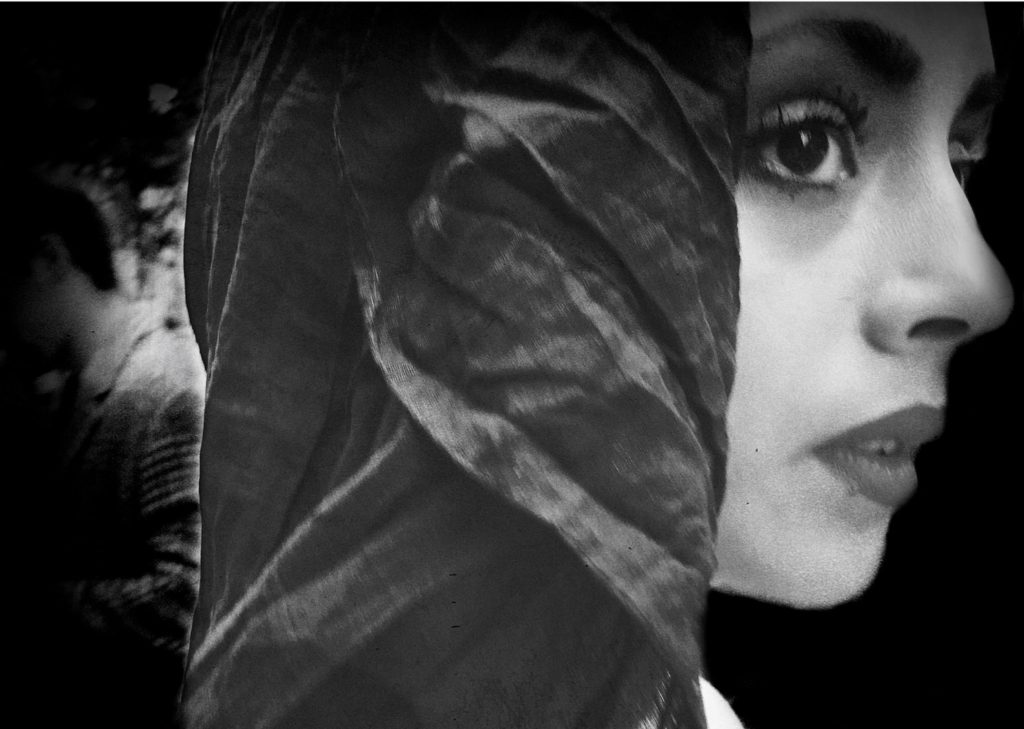
© Caroline de Bertodano
I would rather see the truth in someone’s eyes and the micro expressions that connect to the soul’s windows than an empty one-dimensional being that simply ‘looks good’. Beauty will always change but not at its core. My Mother used to say, ‘feed the brain and soul as well as the body’ and true beauty is those three things that make up the internal natural light, ‘the natural beauty’ and the only thing that will sustain relationships and transcend the chattels of time.
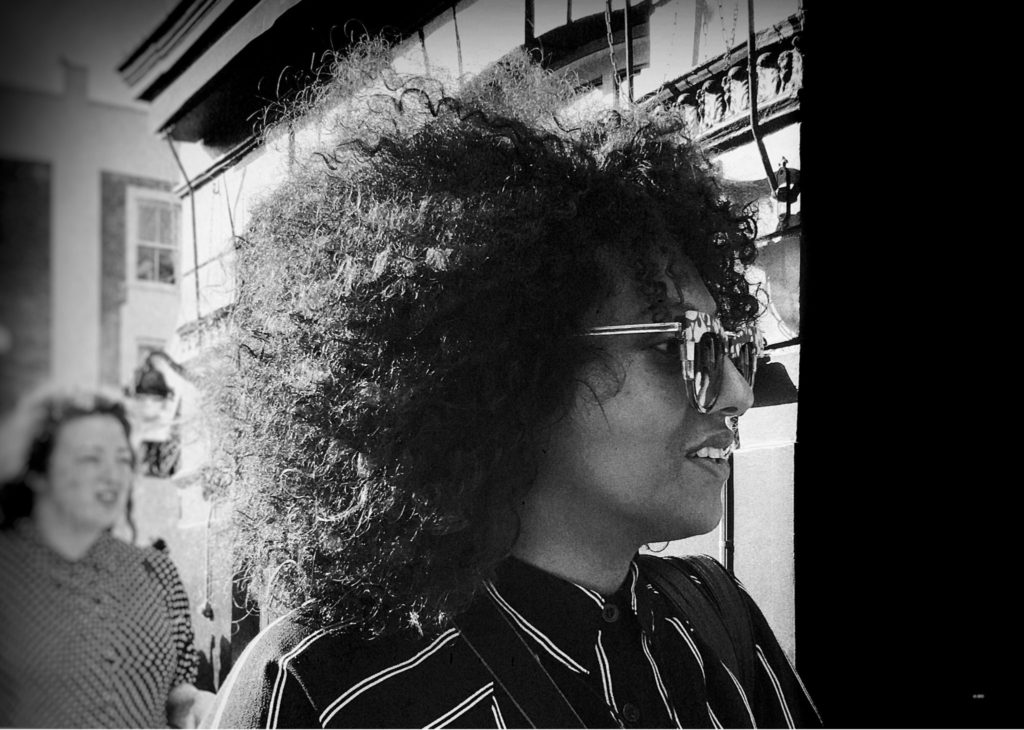
© Caroline de Bertodano
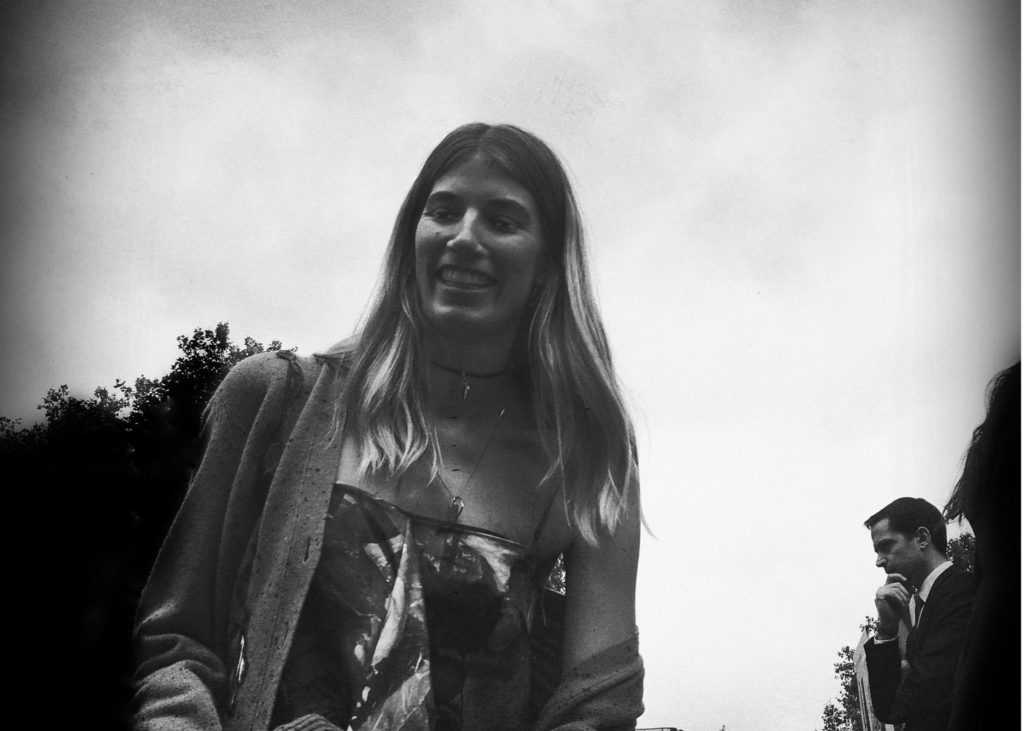
© Caroline de Bertodano
© Caroline de Bertodano 2017

by Kat Meininger | Mar 22, 2017 | Kat Meininger, Stories, Storyteller, You Are Grryo
I Am My Mother’s Daughter: My Journey in Photography

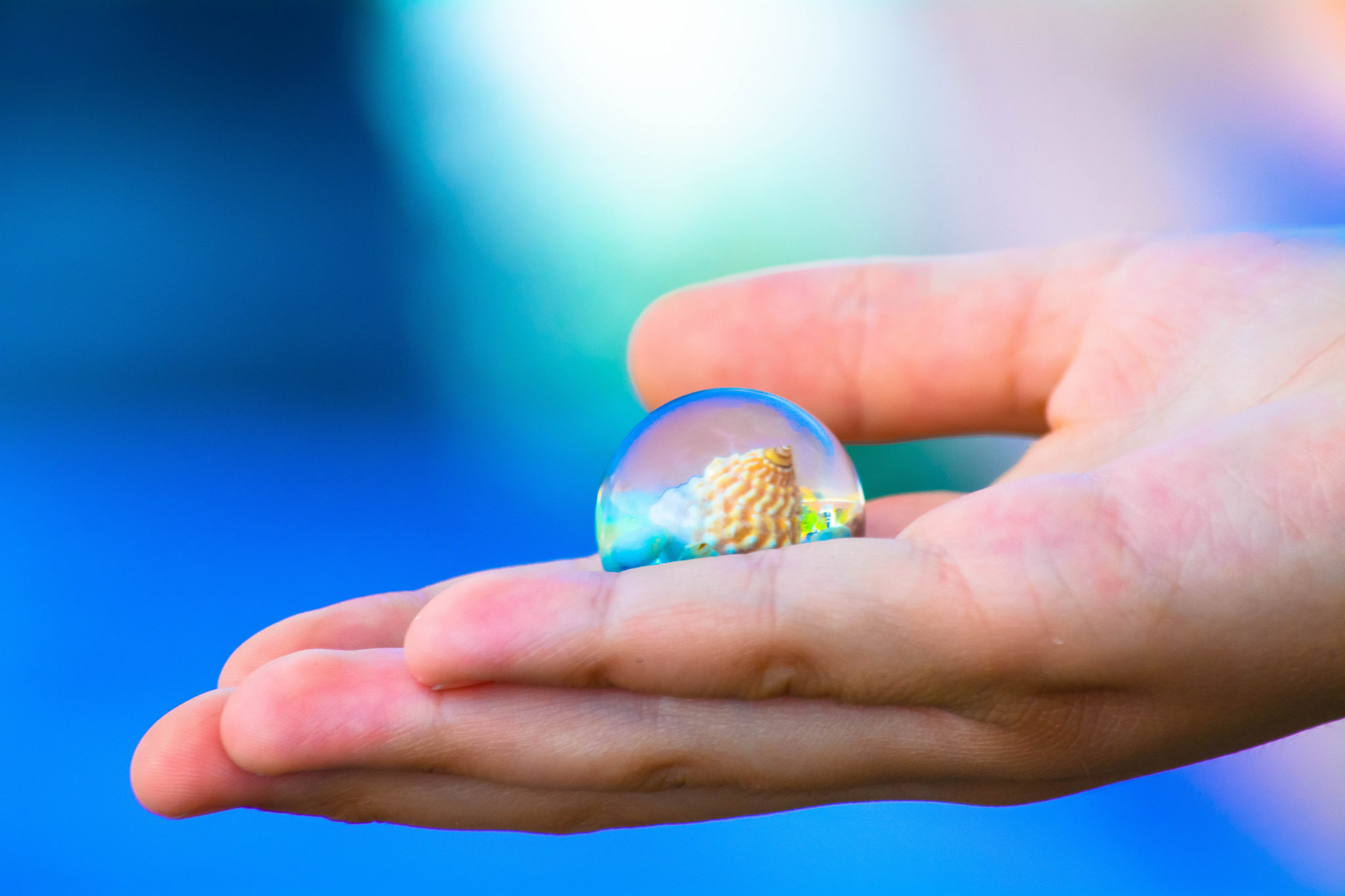
My love affair with photography began with my mother. It was not love at first sight. My mother was always taking pictures. Always. Her camera held permanent residence in her handbag, and our lives were put on instant play-pause whenever she was inspired to take a shot, which was often. As a young child, I never thought about this as her passion, but only as an assigned pose to be endured for as long as it took for her to rummage through her purse to find the camera, get the camera out of its case and then get the shot she was looking for. Full disclosure: I was not in the least bit cooperative. However, I was eventually pulled in by all the photos she took, and I began, not only to appreciate them, but to look at them with a more critical eye. I never offered outright (what I thought of as) constructive criticism of my mother’s photos (an action that would have resulted in any number of unpleasant outcomes…. as a very good-looking and somewhat spoiled woman, my mother was more than a bit vain in all areas of her life).
In my mind, I might have been thinking, she should have turned us more towards the light, or away from the light or taken a few steps forward or backward. My interest was piqued, and for my 8th birthday, my mother bought me a Brownie camera of my own.
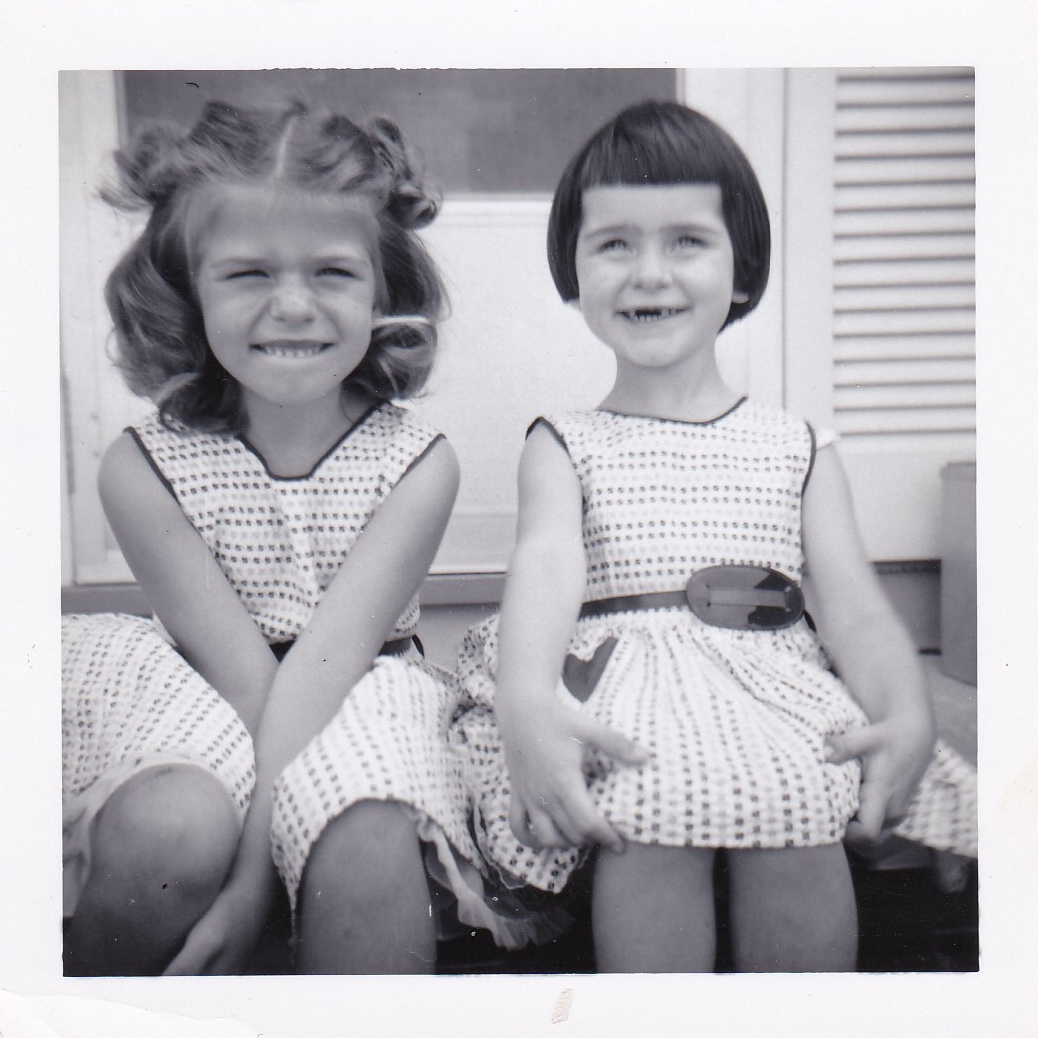
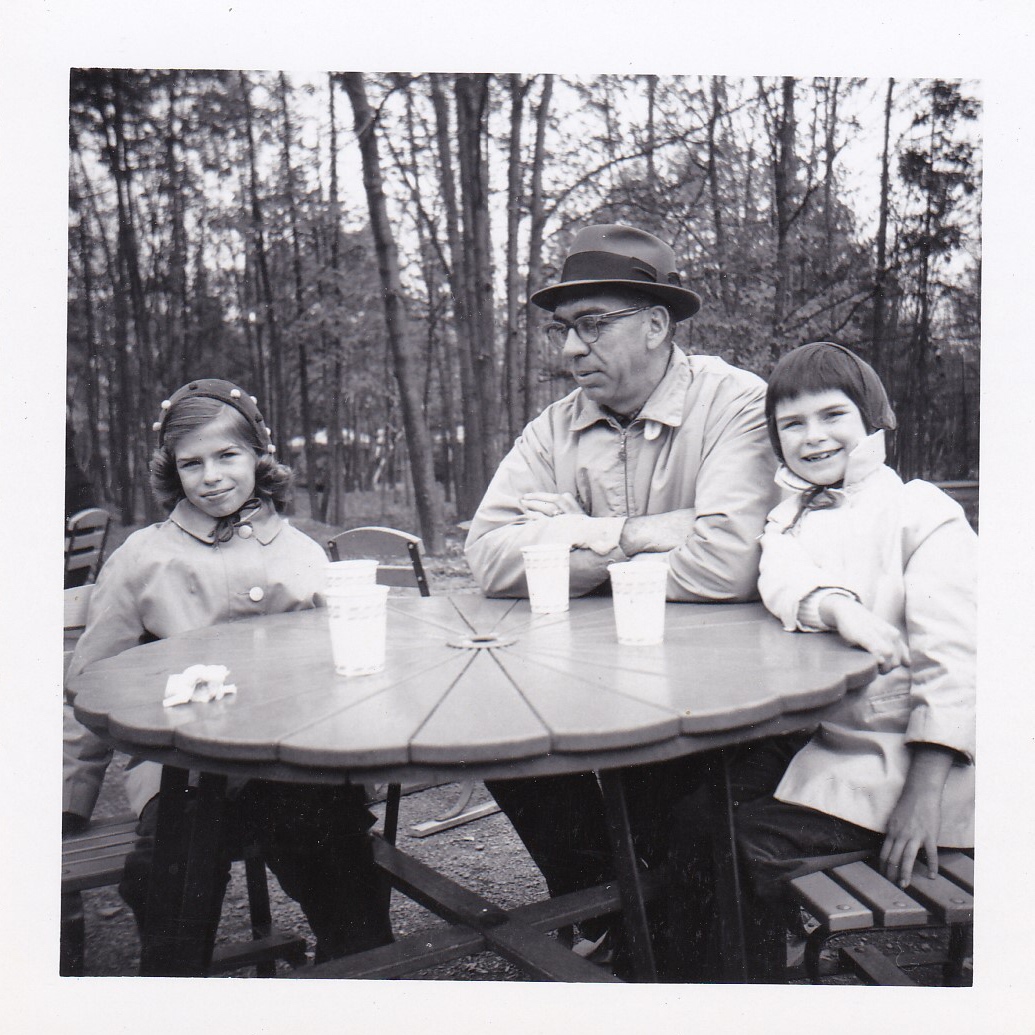
Of course, at first, I began shooting any subject that was close at hand: including my hand, my dolls, my clothes, my record player, my dresser, my closet door, dust bunnies under my bed, whatever struck my young fancy. In those pre-digital days, I was allowed two rolls of film and one pack of flash bulbs per month, as the film, flash bulbs, developing and printing all had to be paid for out of pocket. I quickly learned to become more selective in my photographic endeavors as not to waste those important resources on frivolous subjects. Time passed, my cameras became more sophisticated, I took classes, I poured over photography books by the masters and I discovered that photography was as much a passion for me as it had been for my mother.


Fast forward a good number of years, into the digital age of cameras. No longer was I bound by the constraints of finance: I could take as many pictures as my memory card would hold! It was a wonderful thing, very freeing. I could take more photos, more photos than I ever had in my entire life. I could experiment more, the possibilities were endless. The drawback, at least as far as my family may be concerned, is that the circle was unbroken: I had now become my mother, only more so. Someone closed their eyes? Delete and retake! Is the composition a bit off or the light not quite right? Delete, reposition and retake! Sunlight streaming behind everyone through the trees? Take one shot head on, move to the left and shoot another, move to the right and take a shot, shoot low, shoot high; take as many shots as your heart desires. It’s a photo junkie’s dream come true.


Enter the mobile phone with its ability to take photographs using a built-in camera. A mobile phone (or as I prefer to call it, my camera phone) that can be taken wherever I roam. This little bit of wizardry (or little bit of heaven) is nothing if not easily portable. This has opened up a whole new world, negating the need to have an unwieldy camera hanging from my neck or a heavy backpack full of lenses and equipment slung over my shoulder unless I choose to go shooting pics old school. Taking photos no longer needs to be a delicate balancing act. As I did when I first began, I can simply point my camera phone and shoot. And, as my mother before me, I now carry my camera in my purse (or in a pinch, in my pocket.)
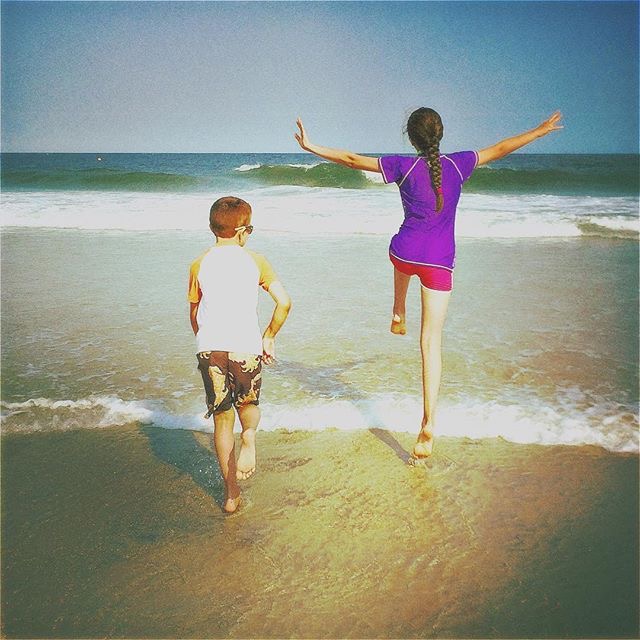

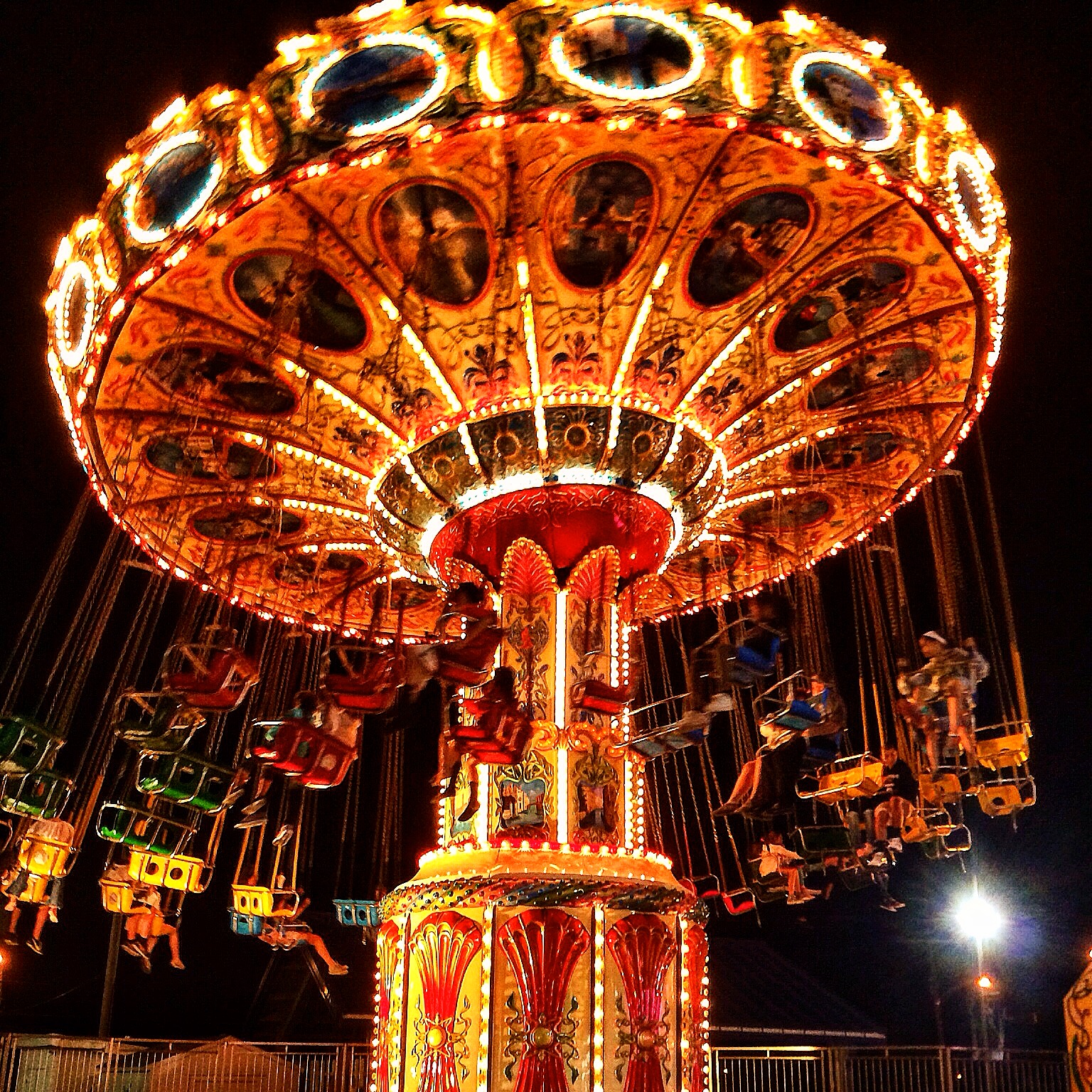
It might have ended here if not for all those glorious photo apps. I could go on for days, but prefer to focus on my favorite camera app, Hipstamatic. I discovered mobile photography and the Hipstamatic app within months of each other in early 2012. Left reeling from the deaths of my father, my father-in-law and my mother within a three month period in late 2011, I desperately needed an all-consuming distraction. My first iPhone (4S) and the Hipstamatic app fit that bill to a “T.” I believe I was drawn to Hipstamatic because it’s a neat little app designed to recreate photos produced by the so-called toy cameras of the 50s, 60s and 70s. It’s so much more than that, because along with numerous combinations of lens, film and flash filters, there is a full editing suite, which taps into my creative side. I can play with its features in so many more ways than I could with the actual toy cameras I once owned.
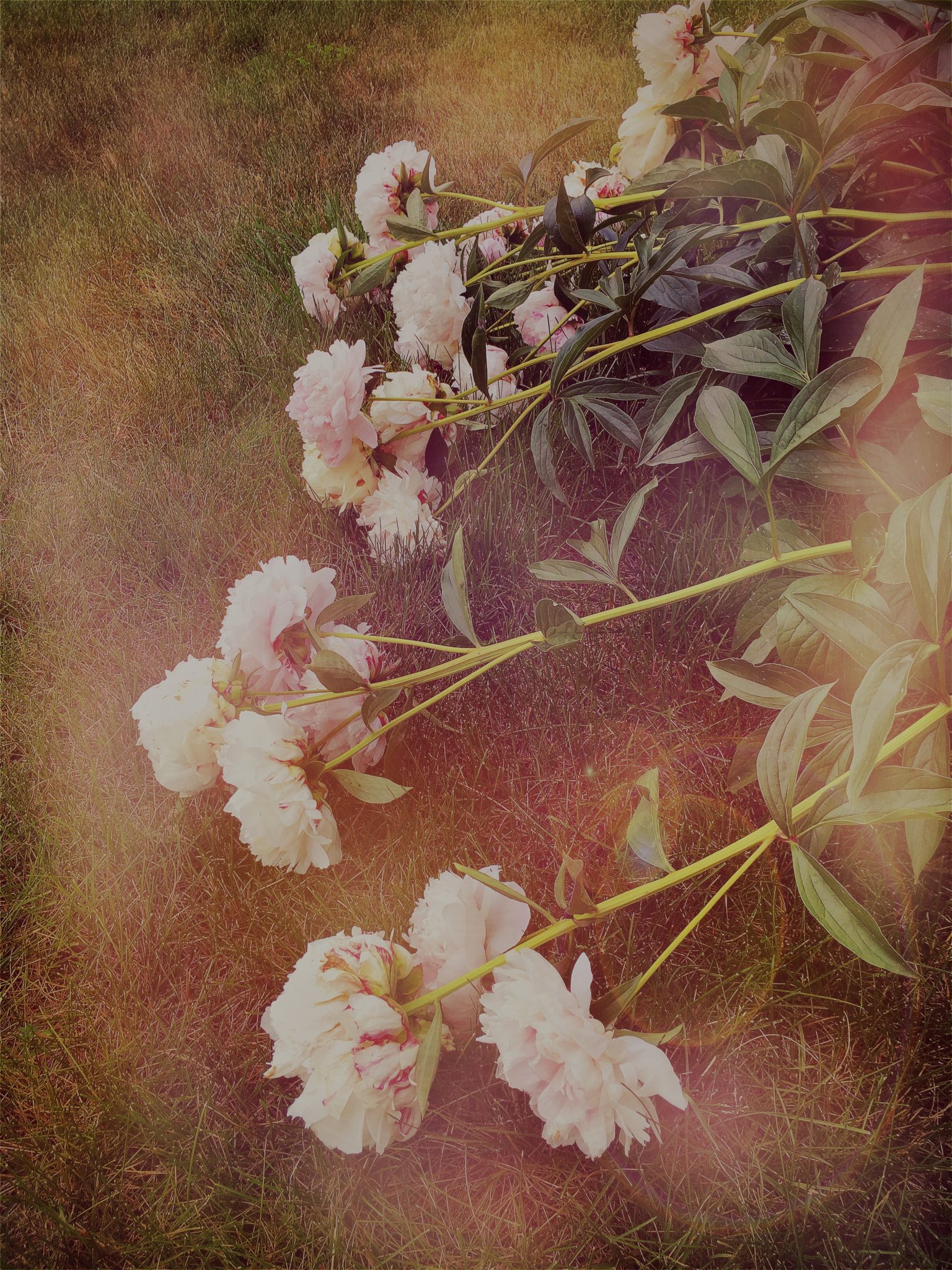
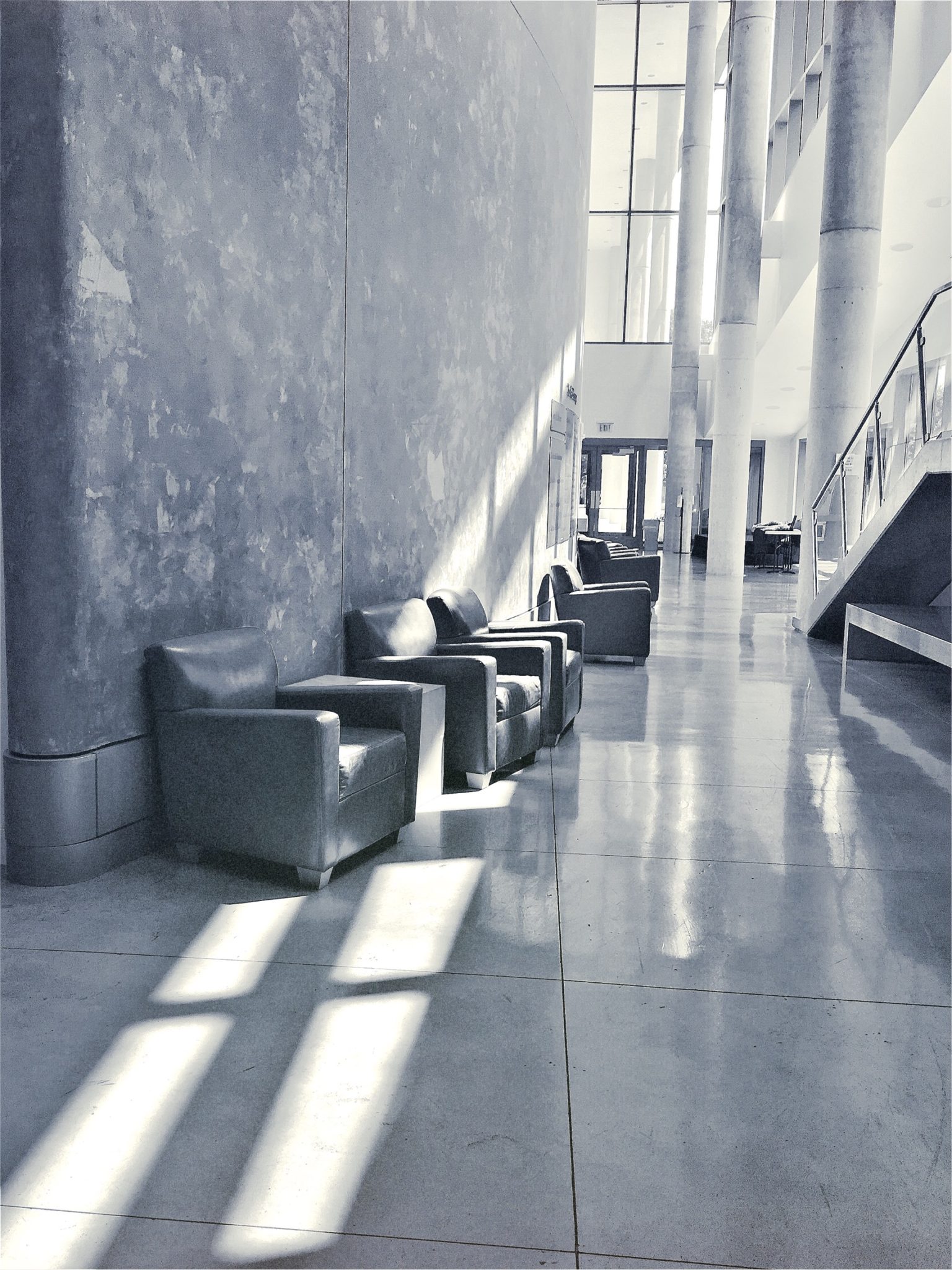
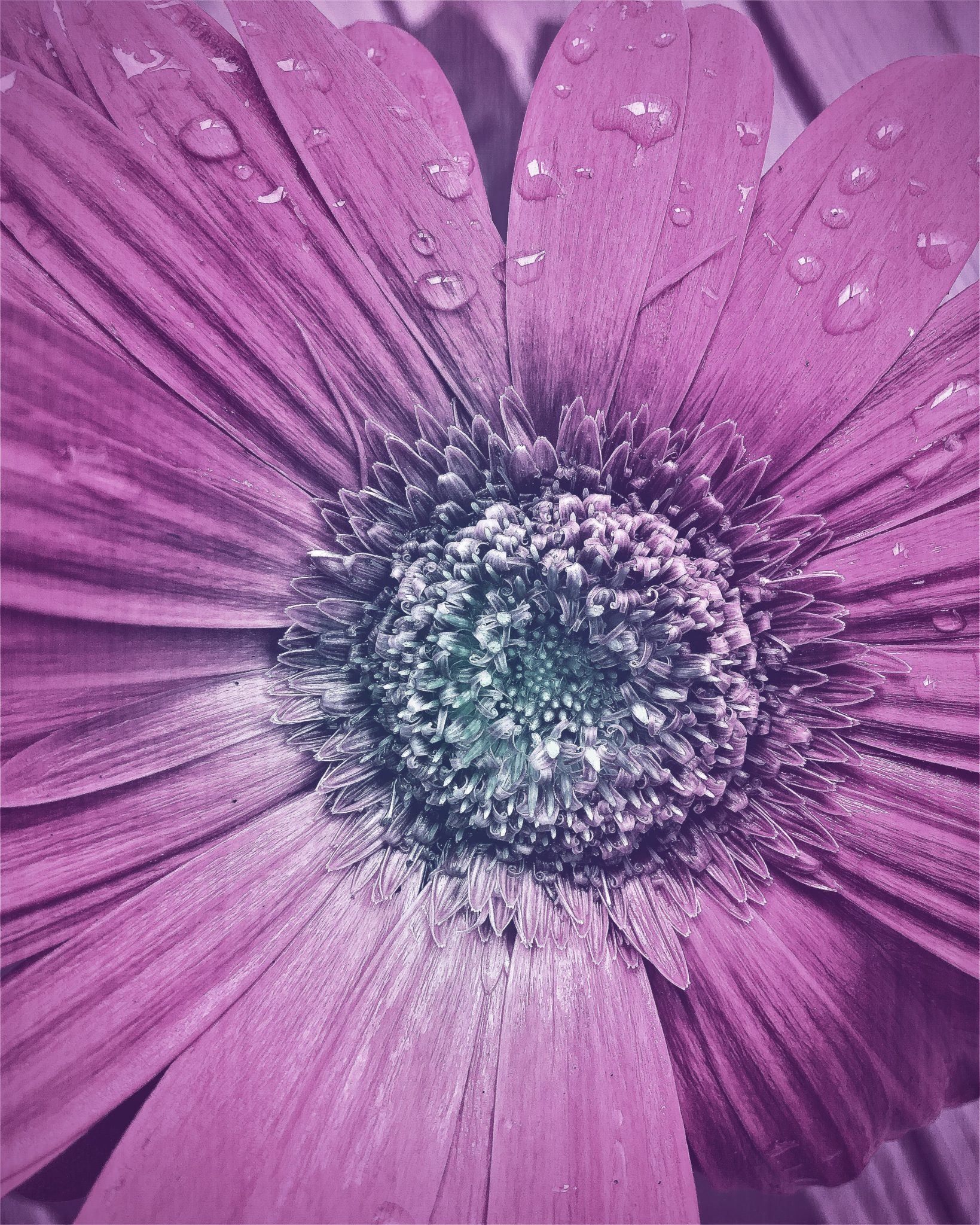
Now that I am retired, I am free to wander the countryside, happily snapping away to my heart’s content. The child who wanted to shoot photos of every conceivable subject has been redeemed. There’s a big, beautiful world out there, just waiting to have its picture taken. I take enormous pleasure in snapping shots of a favorite tree or bridge in the different light of day, in different seasons. Every hour of every day presents a new photo opportunity. It’s a new view of an old friend with every click of the shutter. Ironically, I cannot stop taking pictures of my children and my grandchildren. I am in constant stealth mode, camera phone in hand, hunting for the perfect candid moment. My mother would have gotten a big kick out of this.
Kat Meininger can be found on Instagram: mobile photography as @kats_eye_phone & DSLR photography as @kats_eye_images ; as the founder of @hipsta_crazy & Admin of @photomafia group of photo sharing galleries.































































